

10 Great Movie Speeches for Teaching Rhetoric

Rhetoric can be difficult for students. Heavy speeches often scare students away from enjoying the beauty of rhetoric. Using movie speeches as an introduction to rhetoric is a great alternative to starting with the historic staples. Students do not have to have a working knowledge of these movies in order to analyze them for rhetoric. All of these speeches can be found HERE . This site is my favorite to use because it has a transcript for each speech below the movie clips, which makes it easy for students to analyze the rhetoric after they watch the speeches. Plus, it’s a one stop site. All the speeches you need are in one place.
Are you looking for a great activity to use in your own classroom with movie speeches? Click on the graphic below for my Movie Speech Rhetorical Analysis Resource.

Coach Brooks Addresses the US Hockey Team
“miracle” 2004.
Powerful sports speeches are always a great asset to rhetoric units. Heavy with pathos, this speech uses repetition and anastrophe to grab the attention of the players before they begin an Olympic championship. Students love the emotion of the speech. It’s a great starting speech because the elements are easy to identify.
Oscar Schindler’s Departure Speech
“schindler’s list” 1993.
Oscar Schindler addresses his factory workers and Nazi guards on the eve of the end of the war. His speech is addressed to two groups separately: his factory workers and the Nazi guards. Addressing the workers, Schindler uses parallel structure and antithesis to express his thoughts on their freedom and his guilt. He then turns to the guards and uses antithesis one more time to urge them to do what is right. Moving and emotional, this speech uses a combination of pathos and logos. It takes a little background knowledge for students to understand this one, but it’s worth the time spent.
Lieutenant Colonel Hal Moore Addresses the 7th Calvary
“we were soldiers” 2002.
A list of great movie speeches can’t be complete without a moving battle speech. Almost verbatim from the actual historical speech, Moore’s speech serves as a powerful reminder of universal equality regardless of race or religion. Moore creates a sense of unity among his troops as he promises to fight along side of them throughout the battle.
Mia’s Decision to Become a Princess
“princess diaries” 2001.
An unlikely addition to this list, Mia’s speech is a powerful reminder that sometimes having a platform is all it takes to make a difference in the world. Mia uses rhetorical questions to build her argument as to why she has decided to accept her role as princess. This addition is the result of years of student suggestions for it’s inclusion. I relented and I’m so glad that I did.
President Whitmore Addresses Fighter Pilots
“independence day” 1996.
Aliens and fighter planes grab the attention of students in this inspirational fight speech from the 1996 version of “Independence Day.” President Whitmore uses the holiday to invoke feelings of unity among the fighter pilots and continues his argument by using parallel structure and allusions. If these were to be voted upon, this speech would come out as the collective favorite in my classroom for the past ten years.
T errance Mann- People Will Come
“field of dreams” 1989.
Yes, another sports movie. It’s worth it. I promise. Terrance Mann explains why people will come to Ray’s outrageous dream of a field by using emotion, logic, and hyperbole. His image of what will be stirs both Ray and us to believe that the field will be worth the price.
Harvey Milk’s Address at the Gay Freedom Parade
“milk” 2008.
Students LOVE this speech. An unknown among students, this short speech uses parallel structure, allusion, and pathos to remind the audience that equality does not have one face. If you have not used “Milk” in your classroom for other projects, you need to discover the many uses of this phenomenal film.
Peace by Inches Speech
“on any given sunday” 1999.
Disclaimer: Stong Language (but still PG-13)
This speech deserves a place in this list because of the unlikely inspiration tactics used by coach D’Amato. Most students peg this speech for pathos as first, but upon closer inspection realize that it is logos to the core. He uses the analogy of life as a football game because, after all, “in either game, life or football, the margin for error is so small.” Students love that line. And, frankly, so do I.
Gettysburg Speech
“remember the titans” 2000.
Sometimes is takes a little bit of history to understand today. This rallying speech reminds the players of a recently desegregated team that there are many who died to get them where they are. I find that year after year, my students still know and love this movie- especially my football players! Coach Boone uses a combination of logic and emotion to change the outlook of the players who go on to unite as a team.
The Cowardly Lion on Courage
“the wizard of oz” 1939.
What makes a king out of a slave? COURAGE! This fun and playful speech on courage uses rhetorical questions coupled with parallel structure to reinforce the idea that courage is what makes one great and that courage is what the Cowardly Lion is lacking. Students love the whimsical nature of this speech and are drawn into the rhythm of the language.
Share this:
Published by Modern ELA Materials
Nicole Brown is a content creator and secondary ELA Teacher in East Tennessee. She has been teaching and creating for over twenty years. You can reach her at [email protected]. View all posts by Modern ELA Materials
Leave a comment Cancel reply

- Already have a WordPress.com account? Log in now.
- Subscribe Subscribed
- Copy shortlink
- Report this content
- View post in Reader
- Manage subscriptions
- Collapse this bar

VisualStory®
- Duarte DataStory®
- Presentation Principles™
Slide:ology®
- Slide Design
Speaker Coaching
- Presenting Virtually™
- Illuminate™
- Adaptive Listening™
- Team training
- Learning journeys
- Brand and product storytelling
- Keynotes and events
- Sales enablement
- Communication systems
- Accelerator Lab™
- Our culture
- Our leaders
- Case studies
- Media mentions
- Guides and tools
- Learner support
17 rhetorical devices that will make you sound like Steve Jobs
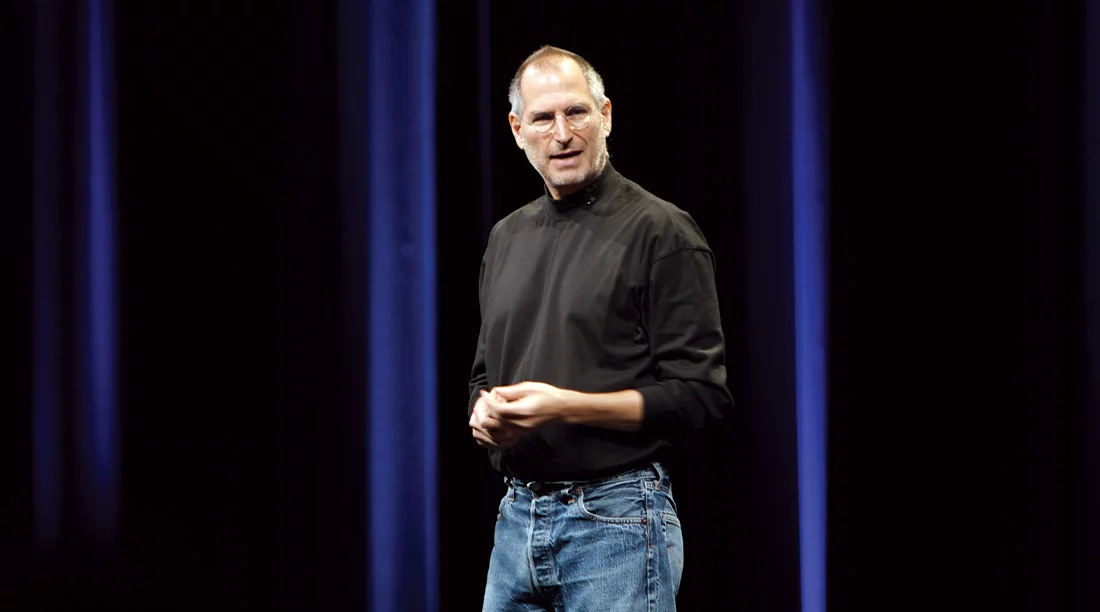
Nancy Duarte
Ask anyone who the best contemporary speakers are, and there’s a pretty good chance they’ll rank Steve Jobs in the top five.
The late, great mind behind Apple didn’t just dream up a company that changed the way humans interact. He was also a visionary and an unparalleled communicator. He knew exactly how to deliver his ideas in a way that moved audiences and left long-lasting impressions.
A number of Jobs’ speeches have garnered attention for being stirring, inspirational, and well-written. Jobs’ Stanford commencement speech, “ Stay Hungry, Stay Foolish ,” given in 2005, is often cited as one of the most powerful speeches of the last few decades, and one of the best graduation speeches ever given (the video has more than 44 million unique views on YouTube.)
There are several reasons that Jobs became such a legendary speaker . First, Jobs wasn’t afraid to be theatrical and dramatic. He used props , included shocking statistics and facts, and illustrated his words visually.

Second, Jobs also knew how to structure a presentation , which included:
- Building suspense
- Keeping listeners engaged
- And helping them envision what their future could look like if they embraced his ideas
We at Duarte call that structure a Presentation Sparkline ™.
Finally, Jobs’ speeches were so powerful because of the way he used rhetorical devices to deliver his message.
What are rhetorical devices?
Rhetoric — which people sometimes call “ the art of language ” — uses figures of speech and persuasive strategies to elevate language and make it more engaging, memorable, and entertaining.
When used properly, rhetorical devices in speeches can be a powerful tool for crafting speeches that stick. By couching his messages using rhetorical techniques, Jobs was able to deliver ideas that would go on to shape the world.
17 rhetorical devices Steve Jobs used in the Macworld 2007 iPhone launch
One of Jobs’ best speeches was given at Macworld 2007 — during the original iPhone launch. In this speech for this product launch , he announced a new tech device that would change the world forever.
Throughout his talk, he used powerful communication tricks and tools:
- He repeated sound bites to make an impression
- He showed the audience the new product in order to shock them
- And he also painted a picture of the future that got people excited about what was coming
But what made this speech one of his best was his use of rhetorical techniques, which made the announcement beautiful to listen to and moving to grasp. Take a look at the 17 most brilliant rhetorical devices used by Jobs during the iPhone launch:
Rhetorical device no. 1: Anaphora (means carrying up or back)
The repetition of a word or phrase at the beginning of every clause.
“ As you know, we’ve got the iPod, best music player in the world. We’ve got the iPod Nano’s, brand new models, colors are back. We’ve got the amazing new iPod Shuffle .”
Rhetorical device no. 2: Epiphora
The repetition of a word or phrase at the end of every clause.
“ Well, these are their home screens . And again, as you recall, this is the iPhone’s home screen .” “ This is what their contacts look like . This is what iPhone’s contacts look like .”
Rhetorical device no. 3: Symploke
The combination of multiple rhetorical techniques, involving one or several anaphora(s) with one or several epiphora(s).
“ In 1984, we introduced the Macintosh, it didn’t just change Apple, it changed the whole computer industry. In 2001, we introduced the first iPods, and … it didn’t just change the way we all listen to music, it changed the entire music industry .”*
*With parallelism and germination.

Rhetorical device no. 4. Germination
The repetition of a word or word group within one sentence.
“ That’s 58 songs every second of every minute of every hour of every day .” “ And so I’ve got voice mail how I wanna listen to it , when I wanna listen to it , in any order I wanna listen to it with visual voice mail .”
Rhetorical device no. 5. Anadiplosis
This rhetorical technique involves the repetition of the last word of a sentence which is also the first word of the following sentence or sequence.
“ And they garnered two percent market share . Two percent market share . iPod had 62 percent market share, and the rest had 36 .”
Rhetorical device no. 6. Asyndeton
Sequence or words or similar expressions without the use of conjunctions.
“ We’ve got movies, TV shows, music, podcasts, photos .”
Rhetorical device no. 7. Polysyndeton
Repetition of conjunctions in a series of coordinated words, phrases, or clauses.
“ It’s got everything from Cocoa and the graphics, and it’s got core animation built in and it’s got the audio and video that OSX is famous for .”
Rhetorical device no. 8. Interrogation
A rhetorical question in which the answer is self-evident.
“ Isn’t that incredible ?” “ Want to see that again ?” “ Pretty cool, huh ?”
Rhetorical device no. 9. Exclamation
An exclamation that expresses the emotional affection of the speaker.
“ I just take my unit here, and I turn it into landscape mode, oh, look what happens! I’m in cover flow .” “ Wha, whoa, what is this ?”
Rhetorical device no. 10. Aporia
A feigned statement of doubt by the speaker and a question to the audience about how he should act.
“ Now, how are we gonna communicate this? We don’t wanna carry around a mouse, right? What are we gonna do ?”
Rhetorical device no. 11. Hyperbole
An exaggeration of the characteristics of an object or circumstance.
“ Best version of Google Maps on the planet, widgets, and all with Edge and Wi-Fi networking .”

Rhetorical device no. 12. Simile
An explicit comparison between two things, usually using “as” or “like.”
“ It works like magic .”
Rhetorical device no. 13. Antitheton
The opposition of two facts of contrasting content.
“ The kind of things you would find on a typical phone, but in a very untypical way now .”
Rhetorical device no. 14. Metaphor
A comparison made by referring to one thing as another, perhaps one of the most popular rhetorical techniques out there.
“ A huge heart transplant to Intel microprocessors .”
Rhetorical device no. 15. Climax
The increase from a weaker expression to a stronger one. Thus, a word sequence is arranged in ascending order.
“ First was the mouse. The second was the click wheel. And now, we’re gonna bring multi-touch to the market .”
Rhetorical device no. 16. Personification
The attribution of human properties toward things or animals, a great rhetorical technique.
“ It already knows how to power manage … and if there’s a new message it will tell me .”
Rhetorical device no. 17. Slogans
Short and striking or memorable phrases used in advertising.
Mr. Jobs also had specific phrases he wanted to repeat over and over. According to Carmine Gallo, this was all intentional since “reinvent the phone” was in the press release Apple sent out before the keynote.
“ Today, Apple is going to reinvent the phone , and here it is .” “ So, we’re gonna reinvent the phone .” “ We wanna reinvent the phone .” “ … You’ll agree, we have reinvented the phone .” “ Today, Apple is reinventing the phone .”
Want help with rhetorical devices in your speeches?
If you have a big speech coming up, the communication coaches at Duarte can help. From working on your pauses and vocal variety to removing filler words or inserting rhetorical devices into your speeches, our team of executive speaker coaches can help!
They have worked on many C-suite speeches for some of the world’s top performing brands, and can help you nail your high-stakes moment, too.

Blog post inspired by the work of Bernhard Kast.
This article was originally published on February 15, 2018. It has been updated in August 2024 for relevancy.
Header image source: Bob Stanfield
Check out these related courses
Captivate™
Improve your public speaking
Overcome bad habits, conquer fears, and increase your confidence in any speaking setting. Discover your strengths and build on them to improve your delivery.
Structure and storyboard a talk
Analyze your audience and organize your ideas into a story structure that will move them. Transform content into visual concepts and build a storyboard for your presentation.
Personalized help for speakers
Up-level your speaking skills with one-on-one support. We’ll help you rehearse your talk, polish your presence, and transform your message delivery.
Craft a persuasive talk
Learn how the world’s greatest speakers use story to persuade. Develop a story structure that powerfully expresses your ideas, applying the principles of empathy, contrast, and variety.
Presentation Principles™
Learn presentation basics
Follow a step-by-step method to write compelling stories, amplify ideas visually, and present with confidence while learning at your own pace.
Turn ideas into visuals
Use visual thinking and design principles to transform information into effective and memorable graphics for presentations.
Create “skimmable” documents
Build helpful pre-reads and impactful leave-behinds with presentation software to support knowledge sharing and decision-making.
Check out these related resources

6 signs your organization needs a better presentation template
Let’s end “Franken-decks” together. Our presentation templates come with custom icon libraries, image libraries, template training, and so much more thanks to our holistic approach.

Why you should absolutely avoid using filler words (and how to actually stop)
Want to learn what are filler words and how to stop using them for good? Use these expert public speaking tips to nail your next board meeting, presentation or keynote and learn to embrace the “pause for effect.”

The ultimate guide to contrast: What your presentation is missing
Need to deliver a great presentation? Master the art of contrast to make sure it’s unforgettable and met with success, every time.

The secret to writing a call to action in a persuasive speech
Struggling to write a call-to-action for your speech or presentation? Make sure you address the 4 audience types so your CTAs are met with success.
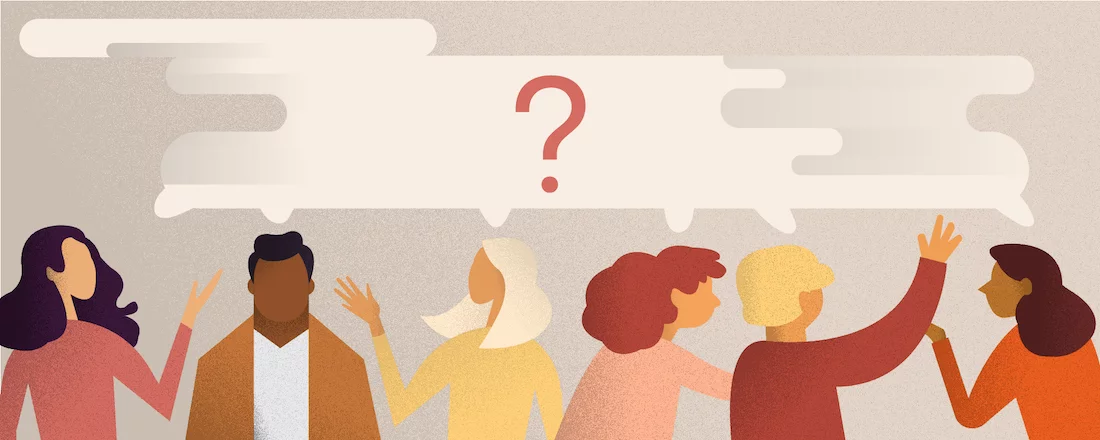
Your top 6 storytelling questions (Answered by an expert storyteller)
Can you “over story” in a business setting? Can you be clunky in your story deliver? Find common storytelling questions and answers in this deep-dive on storytelling.

Everything you need to know about using speaker notes in PowerPoint®
Learn all the Powerpoint hacks with speaker notes from an expert presentation designer. Easily design and prepare for your next presentation with ease.

- Brand Consultation & Market Analysis
- Brand Audit & Strategy
- Competitor Analysis
- Consumer Interviews
- Google Analytics Review
- Persona Development
- SEO Audit & Strategy
- SEO Keyword Research
- Site Mapping & Content Architecture
- Technical Strategy & Roadmapping

- Creative Design & Branding
- Copywriting & Storytelling
- Event & Exhibition
- Inbound Marketing
- Logo & Brand Development
- Mobile App Design & Development
- Presentation Design
- Print Design
- Website Design & Development

- Custom Web & App Development
- API Development
- Augmented Reality App Development
- Front-End Design & Development
- Virtual Reality App Development
- Web App Development
- WordPress Theme Customization
- WordPress Theme Development

- Immersive Reality & New Technologies
- 3D Environment Creation
- Advanced 3D Modeling
- Immersive Story Telling
- Mixed Reality App Development
- Photogrammetry
- Prototyping
- Quantified Biometrics
- Video Production & Animation
- Drone Video
- Film Production
- Mixed Reality Video
- Motion Graphics
- Post Production & Editing
- Script Writing & Story Telling
- Storyboards & Shotlists
- Voiceover & Audio Sourcing

25 Examples of Rhetorical Strategies in Famous Speeches

I’m not trying to be cheesy! An emotional response is a meaningful response, and that reaction stays with you long after the presentation is over. Whenever you think of that speaker or of that topic, your brain will bring back those feelings for you- whether they be of motivation, inspiration, sadness, empathy, or otherwise.
Rhetorical strategies use language to convey special meaning and/or to persuade someone. Basically, these strategies can be used to intentionally invoke feelings in others.
If your first reaction to all this is “Huh?” that’s okay- so was mine. Here’s how I understand it now: rhetorical strategies = emotional connection = memorability.
If you’ve ever considered becoming a master presenter (no judgement if you have), you need these tools in your repertoire ASAP. They’re just so effective!

Don’t believe me? All the cool kids are using (or used) them – I’m talking about thought leader Simon Sinek , technology guru Steve Jobs, past American president Barack Obama, civil rights leader Martin Luther King Jr., and even good old William Shakespeare.
Unless you’re above any of these greatly respected people, I’m betting that you could benefit from a little rhetorical strategy in your next speech!
25 rhetorical strategies from the best minds
We’ve compiled 25 rhetorical strategies from the most memorable presentations on the planet so that your next presentation is undeniably memorable. Ready to begin?
1. Alliteration:
Two or more words in a row that start with the same sound.
“They are part of the finest fighting force that the world has ever known. They have served tour after tour of duty in distant, different, and difficult places.” – Barack Obama
2. Allusion:
A statement that hints at something instead of being direct about it.
“You must borrow me Gargantua’s mouth first. ‘Tis a word too great for any mouth of this age’s size” – Shakespeare
3. Anadiplosis:
Repeating the last word (or words) of a sentence at the beginning of the next sentence.
“Tonight, we are a country awakened to danger and called to defend freedom. Our grief has turned to anger, and anger to resolution.” – George W. Bush
4. Analogy:
A literal comparison of two things.
“A good speech should be like a woman’s skirt: long enough to cover the subject and short enough to create interest.” – Winston Churchill
5. Anaphora:
Using the same word (or words) to begin 2 or more sentences (or paragraphs) that follow each other.
“I trust Hillary to lead this country because I’ve seen her lifelong devotion to our nation’s children – not just her own daughter, who she has raised to perfection but every child who needs a champion: Kids who take the long way to school to avoid the gangs. Kids who wonder how they’ll ever afford college. Kids whose parents don’t speak a word of English but dream of a better life. Kids who look to us to determine who and what they can be.” – Michelle Obama
6. Anastrophe:
A reversal of the typical ordering of a sentence.
“This much we pledge, and more” – JF Kennedy
7. Antistrophe:
Repeating one (or more) words at the end of a sentence.
“It was a creed written into the founding documents that declared the destiny of a nation: Yes, we can. It was whispered by slaves and abolitionists as they blazed a trail towards freedom through the darkest of nights: Yes, we can. It was sung by immigrants as they struck out from distant shores and pioneers who pushed westward against an unforgiving wilderness: Yes, we can” – Barack Obama
8. Antithesis:
A contrast of thoughts.
“That’s one small step for man, one giant leap for mankind.” – Neil Armstrong
9. Asyndeton:
Leaving out conjunction words (as or and) from a sentence.
“…and that government of the people, by the people, for the people shall not perish from the earth.” – Abraham Lincoln
10. Assonance:
Repeating a vowel sound in a sentence.
“I feel the need, the need for speed” – Tom Cruise (from the movie Top Gun)
11. Chiasmus:
The reversal of the latter of two parallel sentences.
“And so, my fellow Americans, ask not what your country can do for you; ask what you can do for your country” – John F. Kennedy
12. Diacope/Tmesis:
Inserting a word (or more) between the components of a compound word.
“Free at last, free at last; thank God almighty, free at last!” – Martin Luther King
13. Epistrophe:
Another name for antistrophe (see above).
“…and that government of the people, by the people, for the people shall not perish from the earth” – Abraham Lincoln
14. Expletive:
Using a word or phrase only to fill out a sentence for grammar, rhythm or balance.
“… we shall never surrender, and even if, which I do not for a moment believe, this Island or a large part of it were subjugated and starving …” – Winston Churchill
15. Germinatio:
The repetition of a word within the sentence.
“That’s 58 songs every second of every minute of every hour of every day.” – Steve Jobs
16. Hyperbole:
Exaggerating a description for emphasis.
“Best version of Google Maps on the planet, widgets, and all with Edge and Wi-Fi networking.” – Steve Jobs
17. Hypophora:
Posing a question that you will answer yourself.
“When the enemy struck on that June day of 1950, what did America do? It did what it always has done in all its times of peril. It appealed to the heroism of its youth” – Dwight D. Eisenhower
18. Litotes:
An understatement that expresses an affirmative by negating its opposite.
“I am not unmindful that some of you have come here out of great trials and tribulations.” – Martin Luther King, Jr.
19. Meiosis:
A massive understatement.
“The situation has developed, not necessarily to our advantage” – Emperor Hirohito, announcing to the Japanese people that atomic bombs had been dropped on Hiroshima and Nagasaki
20. Metaphor:
Comparing two unlike objects to provide a clearer description.
“All the world’s a stage, and all the men and women merely players.” – William Shakespeare
21. Parallelism:
using a sequence of identical constructions in writing
“Tell me and I forget. Teach me and I may remember. Involve me and I will learn.” – Benjamin Franklin
22. Scesis Onomaton:
Repeating two (or more) different words with identical or similar meaning within the same sentence.
“That is heart-breaking, it is wrong, and no one should be treated that way in the United States of America” – Barack Obama
23. Simile:
Comparing two unlike things using the words “like” or “as” with an example.
“We will not be satisfied until justice rolls down like waters, and righteousness like a mighty stream.” – Martin Luther King, Jr.
24. Symploce:
Repeating one (or more) words at the beginning and end of successive sentences.
“In the struggle for peace and justice, we cannot walk alone. In the struggle for opportunity and equality, we cannot walk alone. In the struggle to heal this nation and repair this world, we cannot walk alone” – Barack Obama
25. Tricolon:
A sentence with three clearly defined parts of equal length
Rhetorical strategies improve audience engagement
If you got a little lost amidst the English jargon, here are the 2 main takeaways you need to know:
- Repetition emphasizes meaning Repetition is perhaps the most common rhetorical strategy. Whether it be the repetition of a word, a phrase, or a specific sound, it is incredibly effective. Use this strategy to build meaning behind the essential points you need to get across.
- Comparisons facilitate understanding Comparisons are also an extremely popular strategy, likely because they make the subject matter more relatable. If your audience can identify with what you’re saying, that creates an opportunity for you to cultivate a connection with them.

In sum, the best designed presentations , a slick new outfit, or a commanding voice may impress an audience initially, and can be important to gain their attention, but they lack true substance for any long-term retention. Rhetorical strategies are the single greatest tool for memorability. If you recognized even one of these examples, you just proved that rhetoric strategies are memorable. Why not start using them to your advantage?
Incorporating rhetorical strategies is kind of like learning how to ride a bike – you’re going to think you look unsure the first few times you try and you’re probably going to walk away with some scrapes and bruises. But, once you gain confidence, you’ll be able to ride circles around everyone else.
See what I did there? Here’s to being memorable!
Note: All definitions have been adapted from Your Dictionary .
Looking for more presentation insights?
Check out our Top 30 Most Popular Presentations of All Time , 16 Strategies Used by Pitch Deck Designers , 10 Things to Never Do When Presenting , or read our Top 10 Presentation Tips .
Looking for some creative help for your next presentation? Our team of talented ninja designers would love to assist!

Previous Post The Ultimate Guide to VR Videos
Next post 52 creative infographics that will inspire, leave a reply cancel reply.
Save my name, email, and website in this browser for the next time I comment.
- View All Services
- 1-888-77-NINJA
You can see how this popup was set up in our step-by-step guide: https://wppopupmaker.com/guides/auto-opening-announcement-popups/

Need a Ninja?

My Favorite Speeches for Rhetorical Analysis: 10 Speeches for Middle School ELA and High School English
Teaching rhetorical analysis is one of my absolute favorite units to complete with my students. I love teaching my students about rhetorical strategies and devices, analyzing what makes an effective and persuasive argument, and reading critical speeches with my students. Here is a quick list of some of my favorite speeches for rhetorical analysis.
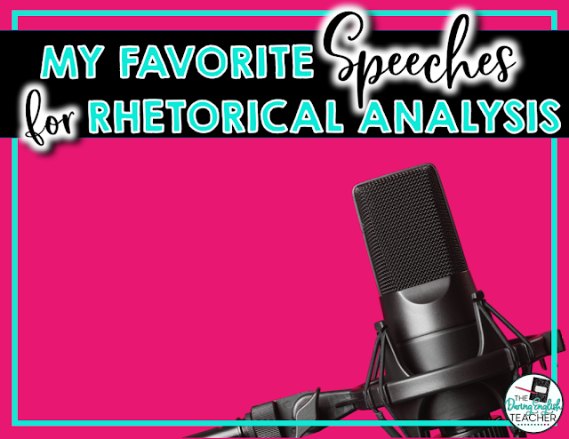
I absolutely LOVE teaching rhetorical analysis. I think it might be one of my favorite units to teach to my high school students. There are just so many different text options to choose from. Here is a list of some of my favorite speeches to include in my rhetorical analysis teaching unit.
10 Speeches for Teaching Rhetorical Analysis
1. the gettysburg address (abraham lincoln).

Some notable things to mention in this speech include allusion and parallel structure. To make your analysis more meaningful, point out these devices to students and explain how these devices enhance the meaning of the text.
Teaching Resource : The Gettysburg Address Rhetorical Analysis Activity Packet
2. Lou Gehrig’s Farewell Speech (Lou Gehrig)
This speech is one that many of my athletes love to analyze, and it is an excellent exemplar text to teach pathos. And like The Gettysburg Address, it is short. This is another speech that you can read, analyze, and even write about in one class period.
When I use this speech in my class, I have students look for examples of pathos. Mainly, I have them look at word choice, tone, and mood. How does Lou Gehrig’s choice of words affect his tone and the overall mood of the speech?
3. I Have a Dream (Martin Luther King, Jr.)

In the classroom, it is important to point out the sermonic feel to the speech and also to have your students look for calls to action and pathos. Have your students look for tone, allusions, and word choice to help them notice these rhetoric expressions throughout it.
Teaching Resource : I Have a Dream Close Read and Rhetorical Analysis
4. Speech at the March on Washington (Josephine Baker)
This is another important speech that held a lot of importance for the changes that needed to be made in America. The speech is a shorter one, so in the classroom, it will not take as long to analyze it, and students can understand the significance of the use of rhetoric in a shorter amount of time than some other speeches.
When teaching this speech, I like to remind my students to search for devices that portray an excellent example of the pathos that is so present in this speech. Some of these devices could be mood, repetition, and diction.
5. Steve Jobs’ Commencement Speech (Steve Jobs)

In class, it is good to have your students annotate and analyze the speech just as they have done for the others. The organization of the speech will help them to notice the similarities and differences between each point Jobs makes.
6. Space Shuttle Challenger (Ronald Reagan)
This speech represents a strong sense of pathos as a movement to help the American people cope with loss after the deaths of the astronauts aboard the Challenger. It is another speech that is not too long, so it should not take a long time to both analyze and annotate the entire speech.
When teaching this speech in class, be sure to mention how pathos is the driving force behind the speech, through the tone and the diction. How does Reagan use emotion to focus on the astronauts as humans, rather than solely focusing on the tragedy?
7. The Perils of Indifference (Elie Wiesel)
This speech is a good one to teach because it both makes students question their own lives, but also how the world works. The speech relies on pathos, and a little ethos too, to get the audience to feel the full effect of the tragedy of the Holocaust and what the speaker went through. It is a long speech so it may take longer for the students to fully grasp all the details that make it such a persuasive speech.
When I teach this speech, I like to have students annotate every place they notice an example of pathos, and then have them explain why in their annotations this makes them feel an emotion. The same with the ethos, and then we can further analyze the rest together.
8. 9/11 Address to the Nation (George W. Bush)
This speech shows another example of the use of pathos in the midst of a tragedy. The President wanted to show the American people how much he was feeling for those lost in the tragedy of 9/11. It is not a long speech, but the amount of emotion within the words is significant for students to notice.
When teaching this speech, it is essential that students look very closely at each part of it, noticing each piece that reveals tone, mood, and other literary devices. How do the different devices add to the pathos of the speech?
FREE TEACHING ACTIVITY : September 11 Address to the Nation Sampler
Teaching Resource : September 11 Address to the Nation Rhetorical Analysis Unit
9. We are Virginia Tech (Nikki Giovanni)
This speech is probably the shortest speech on this list but provides one of the most emotional and pathos-filled rhetoric. This describes another tragedy that is spoken about with pathos to give the audience a safe feeling after such an emotional thing. Students can spend time analyzing the different devices that make the piece so strong in its emotion.
In the classroom, make sure your students make a note of the repetition, and what that does for the speech. Does it make the emotion more impactful? How does it make the audience feel like they are a part of something bigger?
10. Woman’s Right to the Suffrage (Susan B. Anthony)
This is another short speech that holds a lot of power within it. A lot of students will enjoy reading this to see how much the country has changed, and how this speech may have some part in influencing this change. It is a great speech to help teach logos in the classroom, and it will not take a long time to analyze.
Make sure your students notice, and they also understand, the use of allusions within the speech. These allusions help to establish the use of logos, as Anthony wants the use of American historical documents to show how logical her argument is.
Ready-For-You Rhetorical Analysis Teaching Unit
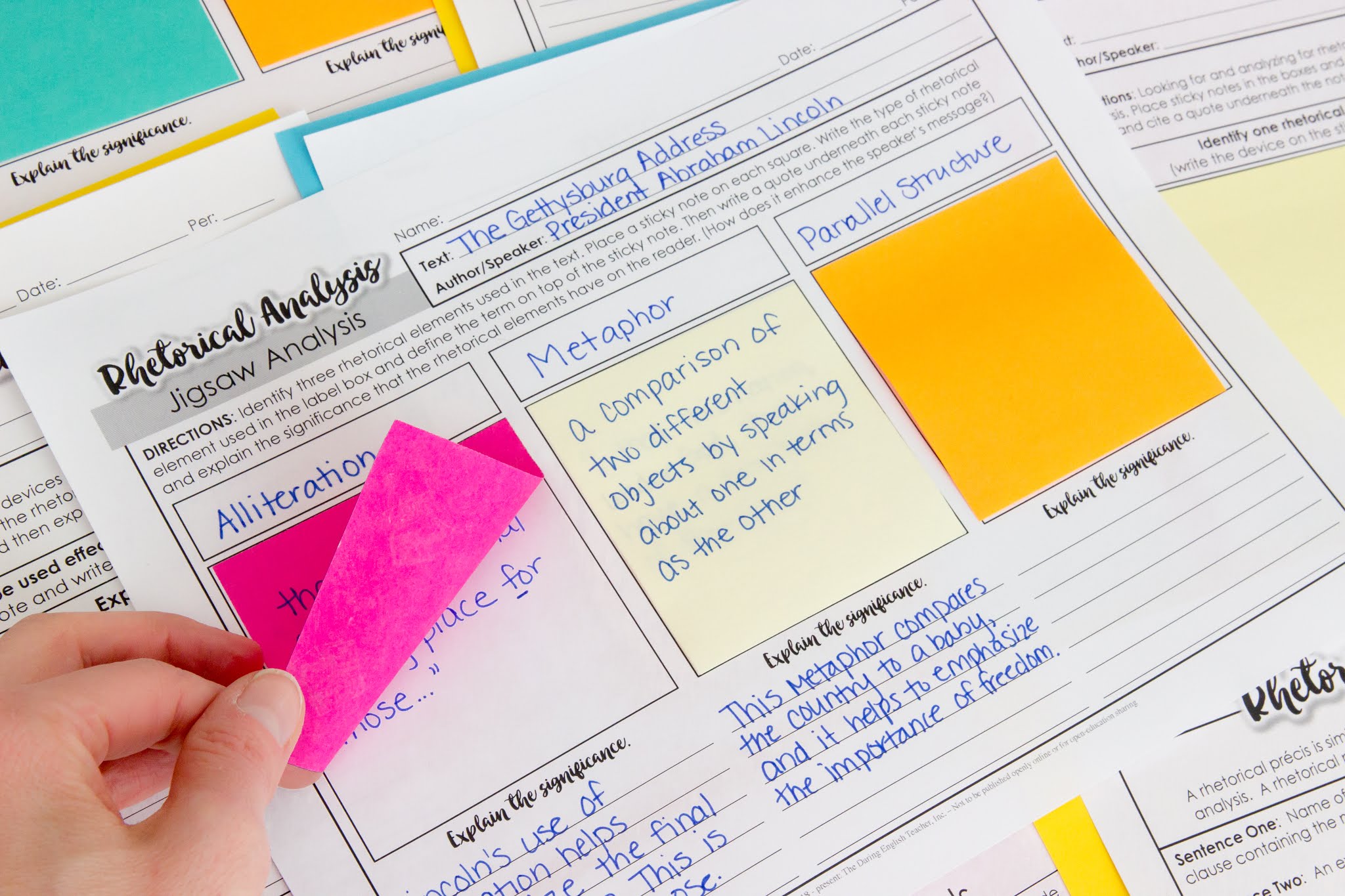
You might also be interested in my blog post about 15 rhetorical analysis questions to ask your students.
Teaching rhetorical analysis and speeches in the classroom is a great way to teach informational text reading standards.
Rhetorical Analysis Teaching Resources:
These resources follow reading standards for informational text and are ideal for secondary ELA teachers.
- Rhetorical Analysis Unit with Sticky Notes
- Ethos, Pathos, Logos: Understanding Rhetorical Appeals\
- Rhetorical Analysis Mini Flip Book
Join the Daring English Teacher community!
Subscribe to receive freebies, teaching ideas, and my latest content by email.
I won’t send you spam. Unsubscribe at any time.
Built with ConvertKit
Leave a Reply Cancel reply
Your email address will not be published. Required fields are marked *
Save my name, email, and website in this browser for the next time I comment.

SUBSCRIBE NOW

60+ Rhetorical Devices with Examples for Effective Persuasion
Rhetorical devices are essential tools in the world of communication, aiding speakers and writers in persuading or engaging their audience effectively. These powerful techniques help convey meaning and evoke emotions, allowing individuals to present their ideas from a specific perspective. As components of the broader concept of rhetoric – the art of effective communication – rhetorical devices can be found in various forms, including language structure, sound, and imagery.
There may be many times that you will hear the use of rhetorical devices in an English conversation or see it in written text, but it can be confusing to understand if you are not sure how they are used. In this article, we are going to look at what rhetorical devices are and what different types of rhetorical devices there are with useful examples.
Rhetorical Devices
What are rhetorical devices.
A rhetorical device is a way of phrasing some words or sentences so that it evokes a specific kind of emotion. It is a great way to get your opinion across and make people believe what you say is a clear absolute truth.
Though history, the best and most prolific writers and speakers have used and developed a plethora of rhetorical devices. People such as Cicero and Demosthenes come to mind or Abraham Lincoln . The last great orator who excelled at using rhetorical devices was the late, great Martin Luther King.
Utilizing rhetorical devices, authors and speakers can appeal to logic or reason (logos), emotions (pathos), or credibility (ethos). Often, these strategies can make a point more convincing, thereby enhancing comprehension and impact on the audience. From metaphors and hyperbole to alliteration and anaphora, numerous rhetorical devices exist, catering to a diverse range of communication styles and purposes.
By mastering the use of rhetorical devices, individuals can significantly improve their writing and speaking abilities, adapting their approach according to the context and target audience. Familiarity with rhetorical devices enables an understanding of when and how to apply specific strategies for maximum effect, ultimately strengthening one’s overall communication prowess.
Types of Rhetorical Devices
Repetition and sound devices.
Various rhetorical devices use the power of repetition and sound to create emphasis, emotion, and catch the reader’s attention. Here are some common examples:
- Anaphora : The repetition of a word or phrase at the beginning of successive clauses. Example: “We shall fight on the beaches, we shall fight on the landing grounds, we shall fight in the fields and in the streets.”
- Alliteration : The repetition of initial consonant sounds in words that are close together. Example: “Peter Piper picked a peck of pickled peppers.”
- Assonance : The repetition of vowel sounds in words that are close together. Example: “The rain in Spain stays mainly in the plain.”
- Consonance : The repetition of consonant sounds in words that are close together. Example: “Pitter patter of little feet.”
- Onomatopoeia : Words that imitate the sounds they represent. Example: “The bees buzzed, and the brook babbled.”
Figurative Language
Figurative language uses words or expressions in a non-literal way to create a vivid picture, emphasize a point, or evoke emotions. Some common examples include:
- Metaphor : A comparison between two unlike things without using “like” or “as”. Example: “Time is a thief.”
- Simile : A comparison between two unlike things using “like” or “as”. Example: “Her smile was as warm as the sun.”
- Personification : Giving human qualities to non-human things. Example: “The wind whispered through the trees.”
- Hyperbole : Deliberate exaggeration for effect. Example: “I’m so hungry, I could eat a horse.”
- Irony : A contrast between expectation and reality. Example: “The fire station burned down.”
- Oxymoron : A combination of contradictory words. Example: “Deafening silence.”
- Synecdoche : Using a part of something to represent the whole. Example: “All hands on deck.”
Persuasive Techniques
Rhetorical devices can be used to persuade an audience by appealing to different aspects of human reasoning. Some well-known persuasive techniques include:
- Logos : Using logic, reason, statistics, and facts to persuade.
- Pathos : Appealing to emotions to persuade.
- Ethos : Establishing credibility and trust by referring to authorities or ethical values.
- Antithesis : Contrasting ideas for emphasis. Example: “It was the best of times, it was the worst of times.”
- Allusion : Making a reference to another work, event, or person to create a connection or make a point. Example: “He was a real Romeo with the ladies.”
- Analogy : A comparison between two similar things to explain a complex concept. Example: “A heart is like a pump.”
- Euphemism : Using a mild or indirect expression to replace a harsh or blunt one. Example: “Passed away” instead of “died.”
- Parallelism : Repeating a grammatical structure for emphasis or balance. Example: “Like father, like son.”
These are just a few examples of the many rhetorical devices that writers and speakers use to convey their messages effectively and memorably. By using repetition, sound patterns, figurative language, and persuasive techniques, communicators can engage their audience, emphasize key points, and achieve the desired effect.
Rhetorical Devices: History and Theory
Greek origins.
Rhetoric has its origins in ancient Greece and has long been linked with public speaking and persuasion. In the Classical period of ancient Greece, around the 5th century BC, rhetors or rhetoricians taught the art of public speaking to fellow citizens in Greek republics. This practice later extended to teaching the children of the wealthy in the Roman Empire. The study of rhetoric developed as a means of communication and persuasion, central to the Greek educational system.
Aristotle’s Modes of Persuasion
A key figure in the history of rhetoric is the Greek philosopher Aristotle , who contributed immensely to the development of rhetorical theory. Aristotle outlined three modes of persuasion in his work, “Rhetoric.” These three modes are:
- Logos : This mode focuses on the logical appeal of an argument, using reasoning and evidence to persuade the audience. Aristotle believed that a well-constructed argument based on reason and facts would lead to more effective persuasion.
- Pathos : In this mode, rhetoricians employ emotional appeals to provoke audiences’ feelings and engage their emotions. By targeting the audience’s values, desires, and fears, pathos helps create a connection between the speaker and the audience.
- Ethos : This mode emphasizes the credibility and character of the speaker. Aristotle argued that persuading an audience requires establishing the speaker’s trustworthiness, expertise, and moral character.
In addition to these modes of persuasion, Aristotle also introduced the concept of a thesis, which is the central argument or main point of a speech or text. This element serves as the foundation upon which the speaker’s persuasive efforts are constructed.
By understanding and applying Aristotle’s modes of persuasion, today’s writers and speakers can increase the effectiveness of their communications, making them more compelling and persuasive. This foundation remains essential for those interested in the history and theory of rhetoric.
Rhetorical Devices List
Common rhetorical devices.
Here is a list of rhetorical devices most commonly used:
1. Alliteration
Another name for alliteration is tongue twisters . You might remember them from your youth. Any time you notice that a few words, one after the other share the first few, initial consonant sounds you have yourself an example of alliteration. But alliteration isn’t only used in children’s tongue twisters, such as “ she sells seashells “, they are also used by brands to make their names much more memorable, for example, “ Krispy Kreme “.
2. Allusion
Every time you make a reference to some places, events, or a person you are making an allusion . For example, one could say, ” I’m not Sherlock Holmes to figure that out ”. It is helpful when one tries to get a point across because you can reference something well known and not explain something at great length.
3. Amplification
Repeating the same word one after the other, combined with an adjective or two makes it seems stronger, more significant. That is the rhetorical device called amplification. For example, “ his face is red, so so red “. It could indicate that the colour in somebody’s face is of an extraordinary shade of red, to a worrying degree.
Sometimes the easiest way to explain things is to strike a parallel with some other thing that is quite similar to it. But one has to be careful with analogies, not every analogy is true One of the most basic logical fallacies is the Conclusion from Analogy. An analogy would be, “ She is as pale as a ghost “.
5. Anaphora
This is one of the rhetorical devices that Shakespeare loved. Anaphora is defined as repeating a single word or a phrase in successive phrases. For example, “ some glory in their birth, some in their skill, some in their wealth “. The repetition of the word some in our examples gives the quote its rhythm, playfulness, and power. It does not come as a surprise that anaphora is a staple device for many famous poets. But poets aren’t the only ones who can benefit from this device, any learned orator can.
6. Antanagoge
Sometimes referred to as a backhand compliment, an antanagoge is when you combined a positive and a negative statement together. For example, “ this summer season was dry, but not as dry as the one back in 2012 .”
7. Antimetabole
Repeating words in verse order is what antimetabole is all about. One of the most famous examples comes from the father of philosophy, Socrates. he said, “ eat to live, not live to eat “.
8. Antiphrasis
This device is used for ironic, sarcastic and humoristic effect. One of the biggest proponents of this rhetorical device was the French nobleman, and maxim writer, Baron De Rouchefoult. It usually makes fun of opposites. So you can call a really ugly painting, such a Mona Lisa, or a very slow person, Usain Bolt.
9. Antithesis
Any time you make a connection between two events, people or things you are using this rhetorical device. The most celebrated and repeated example of antithesis was Neil Armstrong’s speech after he set foot on the moon. Another example would be a quote from the famous German writer Goethe, who said, “ love, is ideal, marriage real “. It means that it is one thing to love someone, but spending your entire life with a person is something completely different, real without illusions.
10. Appositive
If you want to describe a noun better, with another noun, you are using appositive. For example, Alexander of Macedonia, master general. In this example, the master general is the appositive and describes something noteworthy about this historical figure.
11. Enumeratio
Enumeratio is when you try to make some sort of point my numbering things one after the other. Salespeople often use this when they want to sell you something. They will list every feature the item has in an attempt to make you agree with them. They hope to spark your interest in purchasing this item that way.
12. Epithet
An epithet is a word that summarises the most important thing in a person or event. Throughout history, this has been used for propaganda purposes. There are a lot of racially and sexually charged epithets that have brought a lot of pain and suffering to a lot of minorities.
13. Epizeuxis
You can hear this rhetorical device out of the mouths of children, more often than adults. When you repeat the same word, again and again, to add emphasis to an emotion or state of mind you got an epizeuxis. For example, a child might say this when it sees a plate full of vegetables, “ this plate is yucky, yucky, yucky .”
14. Hyperbole
Another term of phrase for hyperbole is an exaggeration. For examples, when you are bored and don’t want to do a specific task you might say, “ This will take forever. ”
15. Litotes
This rhetorical device litotes is used to same something positive with the use of a word or phrase usually reserved for a negative context. For example, one could say “ I’m not unfamiliar with it “. Or to translate, I know a lot about the thing that you are talking about. “ You are not average player, aren’t you? ” which means you are nothing but average. Or one could say “ This is not my first rodeo ” which means, trust me I have a lot more experience than you give me credit for.
16. Metanoia
To make the statement more powerful, you correct the phrase you just used with another one to add emphasis. For example, one could say “ This is the best burger in town, even in the whole state. ”
17. Metaphor
Metaphor is used to compare to things that don’t immediately spring to mind to give one of those things an added quality. For example “ Brevity is the soul of wit “. By this, we mean that saying as much as we can with as little words as we can is a mark of true intelligence.
18. Anacoluthon
Every time there is a sudden break, usually mid-sentence, an anacoluthon is formed. The first part of anacoluthon is never finished because the second part exceeds it in importance. For example “ I was cleaning my garden with -She screamed ”
19. Anadiplosis
This rhetorical device is when you repeat a word or multiple words that have ended one sentence or grammatical structure at the beginning of your next sentence. For example “ I was driving the car. The car that I bought with my own money ”
20. Anastrophe
Anastrophe is the willing inverse of the natural word order in a sentence. This is because you want to put what is most important at the end of your thought. One popular user of this rhetorical device is the fictional, but widely beloved Jedi Master Yoda. He uses multiple rhetorical devices, but anastrophe is certainly his favorite. Some of the most known Yoda quotes are indeed anastrophes. For example, “ Persuade you, I shall ” or “ The path to the dark side, fear is ”
21. Antanaclasis
When you repeat the same word again and again in a few sentences that follow each other, but the repeated word changes meaning in each new sentence or part of a grammatical structure. Probably the most known example of this rhetorical device comes from one of the greatest citizens the USA has ever had, Benjamin Franklin. While debating an opponent once Franklin reportedly said: “ Your argument is sound… all sound “. A wonderful piece of wit combined with the right kind of rhetorical device. He is playing with the meanings of the word sound, which could be something stable and correct and also just noise.
22. Apophasis
Apophasis comes from the Greek phrase and it means “ To say no “. It is the closest rhetorical device to irony and it is accomplished when a speaker brings something up by denying it. For example “ I’m not saying that this article is not a great work of art “.
Every clear, rhetorical expression of doubt is an aporia . Aporia comes in many forms but the most celebrated example is a quote from Shakespeare that almost everyone who went to school as quoted at least once. This example is from Hamlet and it says “ To be or not to be, that is the question. ”
24. Apostrophe
Every time a speaker goes from addressing one individual and abruptly switches his attention to another person or an item is called apostrophe. This other person or item doesn’t even need to be present. Apostrophes can be quite common in an internal monologue a character has in a movie or a novel. For example “ My dear Sun you torture me, What power this heavenly body possesses over us, oh Lord “.

25. Asyndeton
One of the more common and simple rhetorical devices. Many famous sayings and quotes belong to the asyndeton family of rhetorical devices. Asyndeton is the removal of conjunctions between grammatical structures or sentences. Probably the most notable example is the quote by Julius Caezar after he usurped his own city. The quote reads “ I came, I saw, I conquered “. Quite poetic for such a mass-murdering, genocidal maniac.
26. Auxesis
Many writers, of both serious and imaginative books, are though to use Auxesis. The word is greek and it means growth. It is the gradual increase in power and emphasis from one word to the next, erupting at the end of the sentence with its most powerful phrase or word. An example of auxesis would be “ The metal felt warm, then hot, then burning” or “I looked, I smiled, I laughed, I died from laughter “.
27. Bdelygmia
One of the rare examples of rude or abusive language in the whole field of rhetorical devices. A bdelygmia is a rant full of abuses. Nowadays, you are most likely to encounter them at sporting events, especially if the reporter interview a player that has just lost an important game or derby. For example “ If I was raised any differently I might call our coach a complete imbecile incapable of calling the simplest of plays at the right time. Yeah, a total no show, waste of time of a human being “.
28. Cacophony
This rhetorical device cacophony is when you use harsh words to add some effect to your statement or to grab the attention of the person you are addressing. For example, a frustrated lover might say “ Every breath that I take without you close to me feels like a thousand daggers taring my insides apart “. It might sound cruel, manipulative or harsh, but that is the point. Others might see it as a guilt trip, but one lover has the intention to show the other just how painful every moment that they spend apart really is for him or her.
29. Chiasmus
In this rhetorical device Chiasmus , you reverse the order of words, whole grammatical structures or concepts and repeat them in reverse order. One of the most notable examples comes from the Christian savior, half man half God, Jesus Christ. He said to his twelve apostles one time “ Don’t judge unless you want others to judge you “.
30. Commoratio
Every time you are repeating yourself with different words you are using commoratio. Or in other words, whenever you want to say the same thing, but with different words over and over again you are using commoratio. For some reason, British comedy troupes are fond of this rhetorical device. Most notably Monty Python. One such example would be “ He is crazy, nuts, off his rocker, goofy, silly, gone, gonzo, totally gone, whipped like a bat ”
31. Diacope
Borrowing its name from the Greek phrase which means to cut in two, this rhetorical device is the repeating of one word or a whole grammatical construction separated by another word. For example “ In times like these, it is always good to remember that, there were always times like these ” In this example times like these are the grammatical structure that keeps repeating, and the middle part is the divider.
32. Hendiadys
This rhetorical device entails the use of a conjunction between two words that grammatical isn’t really all that necessary. One such example would be “ I’m starting to feel sick and tired of all your rambling ”
33. Dehortatio
This rhetorical device comes from the Latin word and means dissuasion. It is used when you want to give someone a piece of strong advice on what not to do. It has an opposite brother or sister, whatever you want to call it in the family of rhetorical devices called adhortatio. One of the most known examples came from the famous Nazi fighter and British prime minister, Winston Churchill, when he in a speech to the nation, during Nazi air raids said “ Never, never, never give in. No matter how small and insignificant the thing might seem. Never, never give in ”
34. Diatyposis
This rhetorical device comes from Greek. It was probably developed by some of Socrate’s famed sophist opponents. If you want to use an elegant rhetorical device that will help you dictate rules to your audience, this device might be ideal. As in this example from the great eastern philosophical work, Tao Te Ching “ When you rule, don’t try to control. When you think, keep it simple ”
35. Distinctio
Coming from the Latin word that means differentiation. When a speaker wants to leave all ambiguity about a certain word a said and precisely and clearly let his audience know what he is saying by a particular word. This rhetorical device comes up often in political speeches, for example, “ By enemies I mean all of those who didn’t join our cause during the Second World War “.
36. Epanorthosis
Coming from the Greek phrase meaning self-correction. One uses it when one tries to take something back that was earlier said. Or, when one wants to clarify something one has said earlier. This is most often done because the speaker realizes that the thing that he ha said previously didn’t have the desired effect. By applying epanorthosis, the speaker adds more emphasis and power to the things he has previously said to his audience. For example, a speaker might say “ All of, thousands no tens of thousands here today. ”
37. Hyperbaton
This rhetorical device has many cousins. It is of the family of rhetorical devices that inverse the order of words in a sentence or any other grammatical structure, to add strength and emphasis to the most important part of said structure. Yoda, one of the most popular fictional characters of all time, likes to use this device, as well as many romantic poets. An example of this device would be “ One swallow does not a summer make. ”
38. Meiosis
It comes from Greek and it means to make smaller. The use is similar to its Greek origins. It denotes any form of description that is designed to lessen the value or importance of a thing. It can seem similar to litotes but while litotes is more sarcastic, meiosis is far more direct. An example of meiosis might be “ It is only a scratch “. In the case mentioned, the wound the speaker suffered is probably a serious or grave one, but he isn’t discouraged by it or doesn’t want to let his opponents know just how much damage he took. That is why he or she used meiosis to both encourage himself and discourage his or her opponents.
39. Paronomasia
The closes thing to an explanation for this rhetorical device is to claim that it is indeed a sort of ancient word for a pun. Paronomasia that emphasizes the phonic similarities between two words. It can be very prevalent among wordplay, for both adults and children. Some examples are “meet” and “meat”, or “old lord”. It is a great device to use when one wants his words to be ambiguous. One can find this device in many epic poets as well as Shakespeare. They usually use it in the mouth of one of the villains, to mask his true intents.
40. Pleonasm
As we have seen in earlier examples, word repetition and especially its rhythm capture out attention ever so easily. Pleonasm is another rhetorical device that capitulates on this mysterious habit of the human mind and ears. While others repeated words themselves, pleonasm is focused on repeating the same ideal, through multiple grammatical structures, but always trying to express it through different words or phrases. Naturally, and logically, Pleonasm comes from the greek and it means to be excessive. An example of a pleonasm would be “ Our Czar, our ruler, our leader, would like to be brief on the western campaign “.
41. Polyptoton
Coming from, you guessed it, Greek it means many fallings. It is a device where you repeat words that share an origin, like judge and judging or beat and beaten. Repeating those words of equal origin gives the sentence of phrase its signature strength. Some of the most known examples of polyptoton come from religious texts and are really easy to memorize because of their rhythmical setup. The most known example to most people on the western Hemisphere would probably come out of the New Testament, from Matthew’s gospel “ Don’t judge, or you will be judged yourselves .”
42. Polysyndeton
This rhetorical device comes from Greek and roughly translating it, it would mean bound many together. It is accomplished with one conjunction, that is repeated a number of times to combine many phrases or grammatical structures together. The most used conjunction used is probably – and. We find numerous examples of polysyndeton in children when they start to enumerate things. For example “ My mom has beauty, and courage and strength and brains and knows how to cook and is fast ”
43. Scesis Onomaton
Any sentence that is made out of exclusively nouns and adjectives is a scesis onomaton. Sometimes prepositions are added, but verbs are always excluded in the scesis onomaton. An example would be “ That is an opportunity, a chance, a shot ”
44. Sententia
The majority of moral sayings, be it a proverb maxim or aphorism is a form of this rhetorical device. Or in other words, any expression of conventional wisdom. But it has to be expressed in a brief, short sentence, with the most important point expressed at the end. It comes from the Latin word that means sentence. An example of this rhetorical device would be “ War is superior to a bad peace ” or “ Only a man who thinks himself miserable is indeed miserable ”
45. Sentential Adverbs
This rhetorical device is used when we want to give, power or emphasis to an adverb. It is either a single word or a quick and easy phrase that breaks the syntax of the sentence or grammatical construction. So with the help of this word or phrase, we add emphasis on both the word before the break and after the break. An example of sentential adverb would be “ She did not, in fact, divorce her husband ” or “ He won’t, surely, give away his inheritance ”
46. Syllepsis
This rhetorical device comes to use from Greek and it means – a taking. You use this device when you want to give a one-word different meaning than it usually has in relation to other words in the sentence or grammatical structure. A lot of people and even the most astute rhetoricians confuse it with Zeugma. But we won’t get into details here. They can be and usually are used interchangeably. An example of this rhetorical device might be “ His voice reaches so high, and goes way over his smug head ”
47. Symploce
There are many examples of rhetorical devices that use repetition as a means of getting a point across. We all, for some evolutionary reason, like melody and rhythm and rhetoricians know that. One of the most rhythmical and repetitive devices is symploce. To use this device you have to repeat the same word or phrase at the beginning of a couple of continues sentences. But that isn’t all. You also have to repeat a word at the end of each fo those continuous sentences. But it can’t be any word: The word has to have a similar sound to the one you are using at the beginning of those sentences. In other words, you can call symploce a fusion of two devices we have previously mentioned, anaphora and epistrophe. One of the most notable examples come from the famous wit of CK Chesterton. He said “ The lunatic is not the person who lost his mind. The lunatic is the person who lost everything, but his mind ”
48. Synathroesmus
Coming from the Greek word for collection this entry in our list of rhetorical devices is similar to the device accumulatio. But while some devices use the accumulation of words to praise a person or event, this rhetorical device is used to put someone down or to put it harshly, verbally mutilate them. A lot of people who are prone to rants (and let’s face it, Youtube is full of fanboys, and fangirls, who love to rant about every single detail that they like about a certain intellectual property that they allegedly adore) use this device unknowingly. An example of this device would be “ The movie is a soulless, schlocky, amalgamation of everything that is wrong with pop culture ” or “ He is a no-good, clumsy awkward, disease-stricken ape of a man ”
49. Synecdoche
This rhetorical device might have a complicated-sounding name, but it is anything but. Every time you use a part of a sentence or grammatical structure to refer or represent the whole, you are using synecdoche . The same goes for things, people or events. So when people refer to America as a country, they could mean both the US and the two continents. But experience teaches us that they are probably referring to the nation. It is just easier to say one word than the whole structure, The United States of America. It is easy to confuse this device with a metonymy . But remember, metonymy addresses something with a term that is similar, while synecdoche uses a part of something to refer to the whole thing. Like boots to soldiers or wheels for cars.
50. Tapinosis
Another on our growing list of rhetorical devices that are often used, but most often by those that don’t know what they are in fact doing. Another phrase for this rhetorical device would be calling somebody names. It denotes vulgar, or derogatory language. You can hear examples of Tapinosis in children when they fight or call each other all kinds of silly names. Another name for it is humiliatio. But that doesn’t mean it is just a device you use one on one. It can be delivered in speeches as well. There is plenty of tapinosis in every fiery or mad general who addresses his novice recruits. Like in the movie Full Metal Jacket.
An example of such a device would be “ Listen up you maggots. You are nothing but momma’s boys, good or nothing, disgraces of manhood, pieces of dog crap “.
51. Tricolon
Even if the name implies it, this device is not just three colons stacked next to each other. It is indeed, three similar words or phrases, expressed one after the other. This is done to give the description of a thing or person its sort of sense of completeness. A lot of writers use this to give the things they re describing more layers or dimensions, like a word for sight, smell, and hearing. It comes from Greek and it means three units. An example of this rhetorical device would be “ I need three things in a woman. Beauty, jealousy, and no brain ”
52. Topographia
In rhetorics, topographia refers to a lavish or even poetic description of a place. So every time you encounter a detailed description of something in a book you know you are reading an example of topographia.
Coming from the Greek word for question, this device is used by a speaker when we want to discredit someone with a series of aggressive questions that the opponent can’t answer all at once. It is like a torrent of question marks that devours him or her wholly. An example would be “ Who did your party support in 45? On which side of the war were you back then? Were you intending to defend our freedom? The freedom of the world ?”
Logos is a rhetorical device that refers to the use of logic, reasoning, and evidence to persuade an audience. It is often used in argumentative writing or speeches to appeal to the audience’s rationality and intellect. Logos can take many forms, including statistics, facts, expert opinions, and logical arguments. The goal of using logos is to convince the audience that the argument being presented is based on sound reasoning and evidence, and is therefore more likely to be true.
Pathos is a rhetorical device that refers to the use of emotional appeal to persuade an audience. It is often used in writing or speeches to evoke a particular emotional response from the audience, such as sympathy, anger, or fear. Pathos can be achieved through the use of vivid language, imagery, personal anecdotes, and other techniques that appeal to the audience’s emotions. The goal of using pathos is to create a strong emotional connection between the audience and the argument being presented, which can make the audience more receptive to the message and more likely to take action.
Ethos is a rhetorical device that refers to the credibility or trustworthiness of the speaker or writer. It is often used in writing or speeches to establish the author’s authority or expertise on a particular subject. Ethos can be established through various means, such as a speaker’s reputation, professional credentials, or personal experience. The goal of using ethos is to persuade the audience that the argument being presented is credible and trustworthy, and that the author or speaker is knowledgeable and reliable. By establishing ethos, the author or speaker can gain the audience’s confidence and increase the likelihood that the audience will be persuaded by the argument.
Unusual Rhetorical Devices
Kairos refers to the opportune moment for making a persuasive argument or taking action. It’s about understanding the context and seizing the right moment to maximize the impact of your message. For example, a political candidate might use kairos to address a controversial topic when public opinion is shifting in their favor.
58. Anacoluthon
Anacoluthon is a deliberate disruption of the syntax within a sentence, often used to emphasize a point or create a sense of confusion. It could be a sudden change in the grammatical structure or an interruption mid-sentence. For instance: “You really need to – can’t you see what’s happening here?”
59. Hypophora
Hypophora is when a speaker or writer raises a question and then immediately answers it. This rhetorical device can be used to guide readers through a series of thoughts or to make a point more emphatically. Example: “Why do we continue to pollute our environment? The answer lies in our dependence on fossil fuels.”
60. Antiphrasis
Antiphrasis is the use of a word or phrase with a meaning that is opposite to or contradicts its usual meaning, often for ironic or humorous effect. For example, describing a chaotic situation as “organized chaos” or calling a large person “Tiny.”
| Epithet | A descriptive word or phrase that characterizes a person or thing, often used to emphasize a certain aspect. Example: “Alexander the Great” |
| Litotes | A figure of speech in which an affirmative is expressed by negating its opposite. Example: “She’s not the friendliest person” (implying she’s unfriendly) |
| Antanagoge | Balancing a negative statement or event with a positive one to lessen the impact. Example: “The car’s old, but it runs well” |
61. Dysphemism
Dysphemism is the use of harsh or derogatory language to describe something or someone, often for the purpose of criticism or humor. For example, calling taxes “government theft” or referring to a leader as a “tyrant.”
62. Asterismos
Asterismos is a rhetorical device where a word or phrase is placed at the beginning of a sentence or paragraph to draw attention to the following information. For instance: “Listen, everyone here needs to understand the rules.”
63. Paregmenon
Paregmenon is the repetition of words derived from the same root, used to create emphasis or wordplay. Example: “The team is working diligently to create a diligent workforce.” Here, “diligently” and “diligent” both share the same root.
Rhetorical Devices Examples
Examples of rhetorical devices in speeches and events.
Rhetorical devices are essential tools for speakers to effectively communicate their message and engage their audience. By employing various linguistic techniques, speakers can elevate their speech, making it more impactful and memorable.
One of the most famous speeches in history is John F. Kennedy’s inaugural address. Throughout his speech, JFK employed numerous rhetorical devices to inspire and persuade the audience. For instance, he used parallelism in the well-known phrase, “Ask not what your country can do for you—ask what you can do for your country.” This structure highlights the contrast and emphasizes the speaker’s message.
In addition to parallelism , speakers often use other rhetorical devices such as:
- Metaphor: Comparing two things by stating one is the other, e.g., “The world is a stage.”
- Hyperbole: Intentional exaggeration for effect, e.g., “I’m so hungry, I could eat a horse.”
- Alliteration: Repetition of initial consonant sounds, e.g., “She sells seashells by the seashore.”
- Assonance: Repetition of vowel sounds within words, e.g., “How now, brown cow?”
- Anaphora: Repetition of the same word or phrase at the beginning of successive clauses, e.g., “We shall fight on the beaches, we shall fight on the landing grounds, we shall fight in the fields.”
These techniques can not only emphasize important points but also make the language more memorable and engaging for the audience.
Moreover, the use of rhetorical devices can significantly impact the tone and mood of the speech. For example, a speaker may employ irony to point out a discrepancy or create humor in the listener by using an unexpected twist in their language.
Working with rhetorical devices and mastering their usage is crucial for a speaker to enhance their speech’s overall impact. By understanding the linguistic tools at their disposal, speakers can effectively connect with their audience, leave a lasting impression, and ultimately achieve their communication goals.
Rhetoric in Literature and Poetry
In literature and poetry, the use of rhetorical devices plays a crucial role in offering powerful and persuasive language. These literary elements are employed by writers to convince or persuade their audience through logos, pathos, and ethos.
Literary Devices in Poetry
Poetry often relies on linguistic tools like figurative language and well-known figures of speech , which are considered rhetorical devices. Some common examples include metaphors, similes, and personification. The use of these devices enables poets to create vivid images and evoke emotions, enhancing the reader’s experience.
Examples of Rhetorical Devices in Literature
Various rhetorical devices are used in different types of writing, including narrative and descriptive writing. Some of these include:
- Anaphora : The repetition of a word or phrase at the beginning of consecutive clauses or sentences.
- Hyperbole : Deliberate exaggeration for dramatic or humorous effect.
- Irony : A contrast between the intended meaning and the actual meaning of a word or expression, often for sarcastic, humorous, or dramatic purposes.
When effectively employed, rhetorical devices can help authors produce memorable and influential literary works, reinforcing their messages.
Rhetoric in Music and Place
Rhetorical techniques can also be found in other forms of art, such as music and the description of places. In music, lyrics and composition can be crafted to create an emotional response or convey a specific message. For instance, a songwriter might utilize metaphors and similes in their lyrics, while the melody and rhythm of the music might provoke an emotional response.
Similarly, the description of a place can be enhanced by the use of rhetorical devices. Writers can use figurative language, such as metaphors or personification, to convey the atmosphere and unique qualities of a location more effectively.
In conclusion, rhetorical devices serve as powerful linguistic tools for conveying emotion, imagery, and persuasion across various forms of art and writing, such as literature, poetry, music, and descriptions of places.
Rhetorical Devices Examples in Pop Culture
Rhetorical devices are often used in pop culture to create memorable moments and engage audiences. These techniques can be found in various forms of media, including television shows, movies, commercials, and music.
One example of rhetorical devices in pop culture can be found in the Star Wars franchise, where the character Yoda uses distinctive speech patterns as a form of anastrophe. This is a device where words are deliberately arranged in an unusual order to create emphasis or an attention-grabbing effect. Yoda’s unique way of speaking has become synonymous with wisdom and has made the character a cultural icon.
In music, artists employ various rhetorical devices to enhance their lyrics and evoke emotional responses from their audience. For instance, Beyoncé’s album “Lemonade” incorporates a wide range of rhetorical devices such as alliteration, metaphor, and imagery. These techniques contribute to the album’s powerful narrative, which explores themes of love, betrayal, and empowerment.
Consider the following examples of rhetorical devices in popular songs:
Alliteration : The repetition of consonant sounds at the beginning of words or syllables.
- Example: “Mary, Mary, quite contrary” (traditional nursery rhyme)
Anaphora : The repetition of the same word or phrase at the beginning of successive clauses.
- Example: “We will not flag or fail. We will go on to the end. We will fight in France…” (Winston Churchill)
Metaphor : A figure of speech comparing two unlike things without using “like” or “as.”
- Example: “You’re a sky full of stars” (Coldplay)
Rhetorical devices in pop culture are also prevalent in social media. Memes and viral content often use humor and clever wordplay to deliver messages that resonate with a wide audience. By employing satire, irony, or even puns, creators can make a lasting impression and spread their ideas across various platforms.
In conclusion, rhetorical devices are a crucial element in pop culture, as they help create impactful messages that resonate with audiences. These techniques can be found across different forms of media, from the unique speech patterns of iconic characters like Yoda to the emotional lyrics of popular music, like Beyoncé’s “Lemonade.” By understanding and appreciating the use of rhetorical devices in pop culture, one can gain a deeper appreciation for the creativity and thought behind these memorable moments.
Rhetorical Devices: the Role of Emotion and Humor
The use of emotion and humor in rhetorical devices plays a significant role in creating a connection with the audience and enhancing persuasion. Emotions such as happiness, sadness, fear, and anger appeal to the human soul and tap into the shared feelings of humanity. This connection is crucial in building rapport, trust, and understanding between the speaker and the audience.
Humor, in particular, is a powerful rhetorical tool to establish a connection and identification with audience members. By employing humor, a speaker can make their argument more engaging, approachable, and relatable. This connection increases the likelihood that the audience will be receptive to the speaker’s point of view. Additionally, humor often serves to deflate counterarguments and make opposing points of view appear less credible or even absurd.
Emotions, as part of rhetorical appeals, can be traced back to Aristotle’s concepts of ethos, logos, and pathos. Ethos refers to the credibility of the speaker, logos pertains to the logical arguments presented, and pathos focuses on the emotional appeal to the audience. A balanced combination of these appeals is crucial for effective persuasion.
Incorporating emotions and feelings in rhetorical devices can be achieved through various methods, such as:
- Storytelling: Narrating personal experiences, anecdotes, or case studies that evoke emotions.
- Metaphors and analogies: Utilizing figurative language to simplify complex ideas and spark emotional reactions.
- Evocative words or phrases: Intentionally using language that elicits strong emotions.
It is essential to maintain a level of authenticity and moderation when using emotion and humor in rhetorical devices. Over-reliance on emotions or attempting to manipulate the audience’s feelings can lead to reduced credibility and trust. Furthermore, inappropriate use of humor may alienate or offend the audience, ultimately detracting from the speaker’s intended message.
Rhetorical Devices: Audience and Context
Understanding the audience and context is essential when using rhetorical devices in communication. The audience refers to the readers or listeners to whom the message is being conveyed. They may include primary, secondary, and tertiary audiences, depending on the intended reach of the communication. Each audience group has different needs, expectations, backgrounds, and interests, which must be taken into account when crafting a message.
The context, on the other hand, refers to the circumstances surrounding an act of reading or composition. It plays a significant role in shaping the communication, as it dictates the appropriate tone, style, and rhetoric for a particular situation.
Considering the audience and context is crucial for several reasons:
- Effectiveness of communication : Adapting the message to the needs and interests of the audience increases the likelihood that it will resonate with them and achieve the desired effect.
- Appropriate tone and style : Selecting the right rhetorical devices depends on the context and the audience’s preferences. For example, using a more formal tone in a business setting or casual language for a younger audience.
- Persuasion : Understanding the audience’s background and beliefs can guide the use of ethos, logos, and pathos, Aristotle’s established rhetorical techniques. These techniques can elicit emotional responses, credibility, and logical reasoning, influencing the audience’s opinions and decisions.
Writers and speakers can adopt various strategies to tailor their message to the audience and context, some of which include:
- Demographic analysis : Collecting data about the audience’s age, gender, profession, education, culture, and socio-economic status helps in selecting content and rhetorical devices that are relatable and relevant.
- Psychographic analysis : Assessing the audience’s values, attitudes, interests, and opinions enables a more targeted approach to persuasion and influence.
- Situational analysis : Examining factors such as location, time, and the occasion of the communication helps determine the suitable tone and style.
In conclusion, considering the audience and context is paramount when employing rhetorical devices in communication. This approach ensures that the message effectively conveys the intended information, prompts desired reactions, and resonates with the target audience. Successful communication requires a thorough understanding of the audience and the context, shaping both content and delivery accordingly.
Rhetorical Devices Infographics
Rhetorical Devices Infographic 1

Rhetorical Devices Infographic 2

Rhetorical Devices Infographic 3
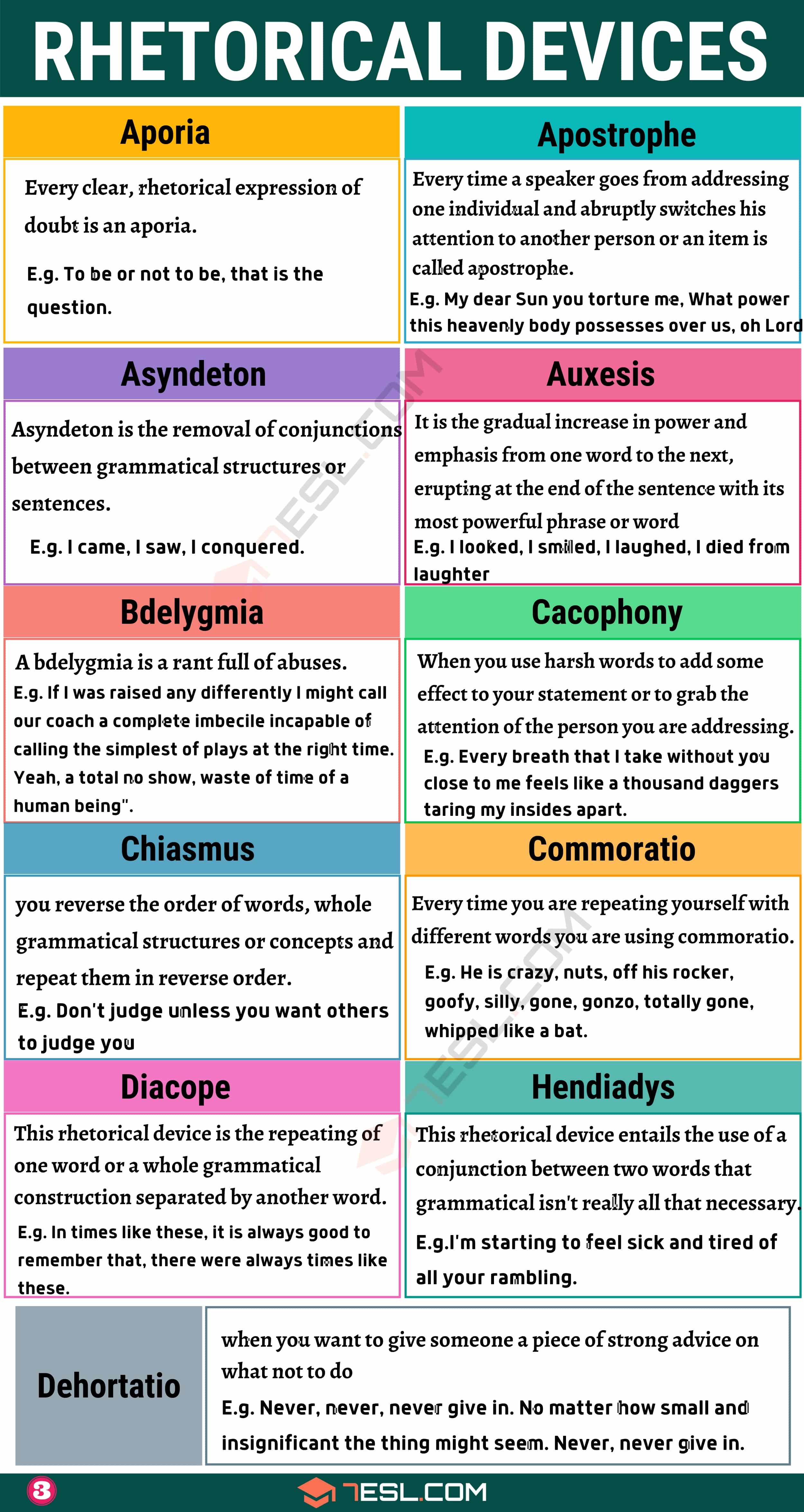
Rhetorical Devices Infographic 4

Rhetorical Devices Infographic 5
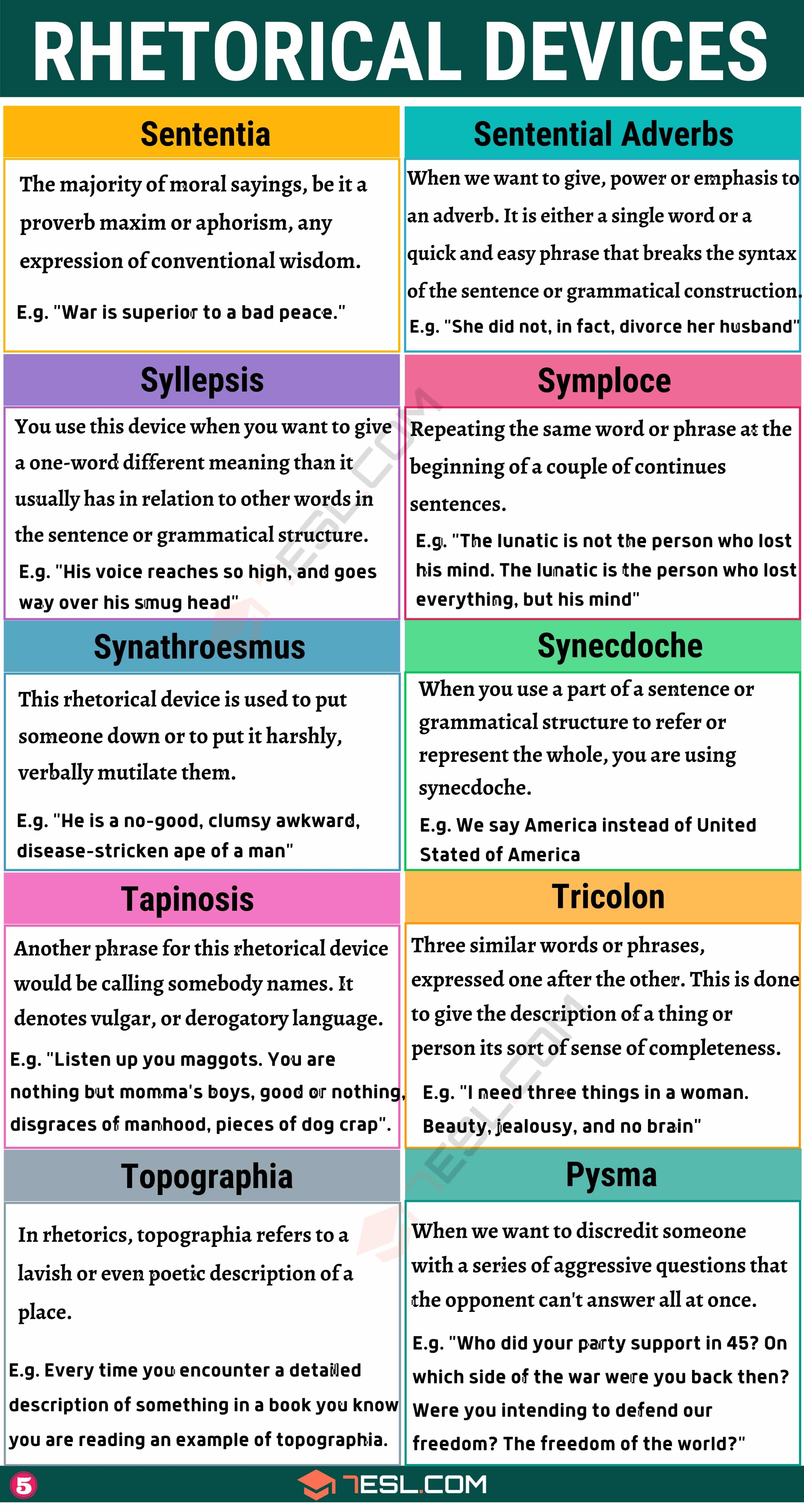
FAQs on Rhetorical Devices
What are rhetorical devices?
Rhetorical devices are techniques used by writers and speakers to effectively communicate, persuade, or express ideas. They help in making language more interesting, engaging, and memorable.
What are some common rhetorical devices?
Some common rhetorical devices include:
- Metaphors and similes: Comparing two different things to highlight their similarities
- Alliteration: Repeating consonant sounds at the beginning of words in close succession
- Hyperbole: Exaggerating for emphasis or emotional effect
- Irony: Using words that convey the opposite meaning of their literal interpretation
- Personification: Attributing human characteristics to inanimate objects, animals, or abstract ideas
Why are rhetorical devices important?
Rhetorical devices are essential for effective communication because they:
- Capture the audience’s attention
- Facilitate understanding
- Enhance the power of persuasion
- Add to the aesthetic appeal of a piece of writing or speech
How can I incorporate rhetorical devices into my writing or speech?
Incorporating rhetorical devices involves:
- Identifying the purpose of your writing or speech (inform, persuade, entertain)
- Choosing the appropriate rhetorical devices to serve that purpose
- Skillfully weaving the devices into your content, ensuring they do not detract from the main message or theme
- Logical Fallacies
- Literary Devices
- Latest Posts
- Insatiable Meaning: What Does It Mean? - January 27, 2024
- Bliss Meaning: What Does “Bliss” Mean? - January 12, 2024
- Judgement vs. Judgment: A Look at Spelling Variations - January 9, 2024
America Ferrera's Glorious 'Barbie' Monologue Explained
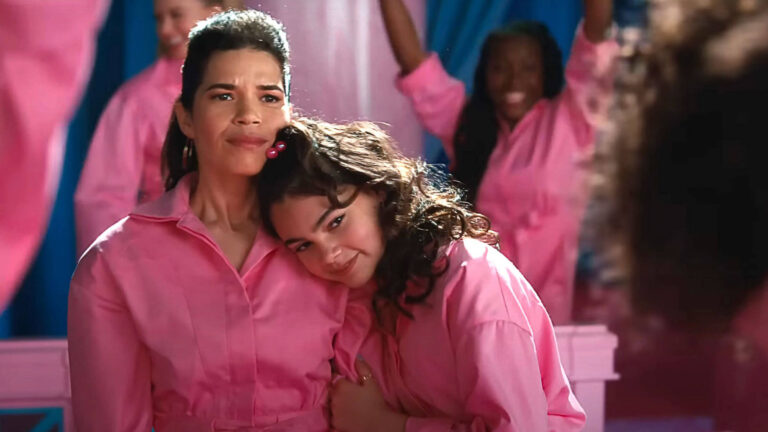
Usually, monologues are frowned upon in movies. If they are included in a script, they often end up on the cutting room floor because screen time is just so precious. But the famous Barbie monologue , delivered by Gloria (America Ferrera) in Act 3, resonates so powerfully that audiences are both emotional and empowered!
While the monologue (from the screenplay written by Greta Gerwig and Noah Baumbach, with input from Ferrera) feels like the unexpressed voice of millions of women, it also pulls various elements of the story together in a coherent, strategic way: theme: check. Spine of the film: check. Empowering message: check. Rally cry for the protagonist: double check!!
Let’s take a look at the Barbie monologue and explore how a well-crafted monologue can drive the narrative forward and sharpen a story.
Read More: 10 Most Thought-Provoking Villain Monologues

Theme vs. Spine
Most of us know what theme is (that thing we had to write essays about in high school when we read books like Catcher in the Rye ), it’s basically the underlying message or reason why the story is being told. Most movies have multiple themes and they are usually presented either as a statement to be disproved or a question to be answered.
In Barbie , some of the themes include self-acceptance, unrealistic expectations, idealized femininity, male vs. female roles in society, and consumerism to name a few. These themes are most clearly expressed when Barbie leaves Barbie Land, goes to the Real World, and heartbreakingly discovers that men rule society (unlike Barbie Land) and most girls shockingly abandon their Barbie dolls at a young age, making Barbie irrelevant to teen and adult women.

'Barbie' (2023)
The spine of a screenplay, however, is the central narrative that drives the plot and the characters' actions. Think of the spine as the essential backbone that connects all the main events and actions of the characters as they explore and question the theme.
The spine of Barbie is Barbie’s journey to the real world to solve the mystery of why she’s malfunctioning. Dolls aren’t supposed to think about death, so something must be really wrong with Barbie! She thinks that if she can solve that mystery, her fallen arches (and her happiness) will return to their normal state. What she’s not expecting is how difficult and confounding the journey will be – especially to an outsider like her.
The Character Gloria
Gloria is a major ally for Barbie when she gets to the Real World. Gloria serves as a tour guide, helping Barbie navigate this foreign land. Gloria not only works for Mattel (Barbie’s creator) and has that inside knowledge, but she’s also a single mom whose own daughter has given up on Barbie dolls, amplifying the rift between mother and daughter. If Gloria can solve Barbie’s problem (i.e.: Barbie’s malfunction), she can solve her own problem with her daughter (i.e.: their relationship malfunction). This makes Gloria’s character the spine of the film personified.
Gloria’s Monologue
Gloria’s monologue not only hits at the heart of what modern women experience in society today, but it also serves as a battle cry for Barbie. Now in Act 3, Barbie feels defeated because she’s unable to discover the source of her malfunctioning – it’s her “All is lost” moment. She feels doomed to live the life of an unhappy plastic toy forever and never know the beauty and mystery of the human world. But Gloria’s monologue may offer Barbie a light at the end of the tunnel.
Let’s Look At The Opening of the Monologue
“It is literally impossible to be a woman. You are so beautiful and so smart, and it kills me that you don't think you're good enough. Like, we have to always be extraordinary, but somehow we're always doing it wrong.”
Though this doesn’t provide a clear answer to Barbie’s issue of why she’s malfunctioning, it does help her to understand the unfair, prejudiced battle she is fighting. The expectations of real women are totally unrealistic, just like those of a Barbie doll. Finally, some common ground and a clear expression of one of the film’s main themes.

Gloria Goes on to Say:
“You have to be thin, but not too thin. And you can never say you want to be thin. You have to say you want to be healthy, but also you have to be thin. You have to have money, but you can't ask for money because that's crass. You have to be a boss, but you can't be mean. You have to lead, but you can't squash other people's ideas. You're supposed to love being a mother but don't talk about your kids all the damn time. You have to be a career woman but also always be looking out for other people. You have to answer for men's bad behavior, which is insane, but if you point that out, you're accused of complaining. You're supposed to stay pretty for men, but not so pretty that you tempt them too much or that you threaten other women because you're supposed to be a part of the sisterhood. But always stand out and always be grateful. But never forget that the system is rigged. So find a way to acknowledge that but also always be grateful. You have to never get old, never be rude, never show off, never be selfish, never fall down, never fail, never show fear, never get out of line.”
Gloria’s frustration and honesty about all the contradictions women face helps Barbie start to understand that women are expected to walk a tightrope between their real selves and who society thinks they should be. However, this is a tightrope where the walker is doomed to fall off! This is a clear expression of the spine of the film and Barbie’s journey.

Gloria Continues:
“It's too hard! It's too contradictory and nobody gives you a medal or says thank you! And it turns out in fact that not only are you doing everything wrong, but also everything is your fault.”
Ding! That’s exactly what Barbie’s been feeling but didn’t know how to express it! She starts to feel inspired as Gloria sums it all up.
“I'm just so tired of watching myself and every single other woman tie herself into knots so that people will like us. And if all of that is also true for a doll just representing women, then I don't even know.”

America Ferrera in 'Barbie' (2023)
This is the battle cry with the answer Barbie’s been searching for: stop worrying if other people like you because you cannot live up to other people’s expectations. You must accept your true self, flaws and all, despite all the twisted messages society sends you. This is easier said than done of course, but it’s the only way to get through human life.
This truthful, heartfelt monologue causes Barbie to snap out of her gloomy state of mind to see the reality of the situation and discover the solution. They must find the courage to fight unrealistic expectations, stand up to patriarchy and commercialism , and live their authentic, flat-footed lives.
Once the monologue is delivered, Barbie and Gloria can team up to help the other brainwashed Barbies escape the male-dominated world Ken has brought to Barbie Land and discover their own authentic selves.

How To Use Monologues in Your Script
This monologue is a tool that allows the main characters (Barbie and Gloria) to find a resolution to their big problems and arc or change. As a screenwriter, determine which character represents the spine of your film and experiment with giving them a third-act monologue. Ask yourself: how does the monologue affect my protagonist? How does it change their trajectory? How does it clear the path to victory?
Monologues don’t have to be put in the third act, they can occur anywhere in the screenplay, but they usually come at an emotional turning point before a plot turning point. The monologue should clarify a character’s feelings to the audience and set in motion the character’s next moves.
Read More: How to Write Memorable and Compelling Monologues
Bottom Line
You may not have room in your screenplay for such a lengthy speech in your script, but just the act of writing the monologue may clarify and focus the story in your own head.
Read More: Barbenheimer: Why Are Barbie and Oppenheimer Battling at the Box Office?
CHECK OUT OUR PREPARATION NOTES SO YOU START YOUR STORY OFF ON THE RIGHT TRACK!

Get Our Screenwriting Newsletter!
Get weekly writing inspiration delivered to your inbox - including industry news, popular articles, and more!
Facebook Comments
Free download.

Screenwriting Resources:

$ 15.00 Original price was: $15.00. $ 12.00 Current price is: $12.00. Add to cart
Popular Posts

Recent Posts

Next Related Post
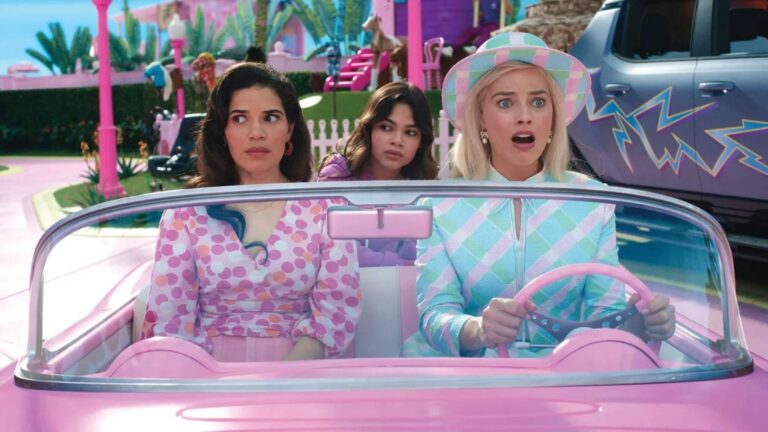
Get Our Newsletter!
Developing your own script.
We'll send you a list of our free eCourses when you subscribe to our newsletter. No strings attached.
You Might Also Like

- Hidden Name
- Comments This field is for validation purposes and should be left unchanged.
Connect With Us
Writing competitions, success stories.
© 2024 ScreenCraft | An Industry Arts Company
Wait! Subscribe to get our free Newsletter
Join our community of over 100,000 screenwriters and get weekly inspiration delivered to your inbox.
Screenwriting Newsletter
Join our community of over 100,000 screenwriters and get weekly inspiration delivered to your inbox:
✓ Popular blog posts and industry news ✓ New ScreenCraft online events ✓ Screenplay competition announcements!
" * " indicates required fields
31 Useful Rhetorical Devices
What is a rhetorical device and why are they used.
As with all fields of serious and complicated human endeavor (that can be considered variously as an art, a science, a profession, or a hobby), there is a technical vocabulary associated with writing. Rhetoric is the name for the study of writing or speaking as a means of communication or persuasion, and though a writer doesn’t need to know the specific labels for certain writing techniques in order to use them effectively, it is sometimes helpful to have a handy taxonomy for the ways in which words and ideas are arranged. This can help to discuss and isolate ideas that might otherwise become abstract and confusing. As with the word rhetoric itself, many of these rhetorical devices come from Greek.

Ready, set, rhetoric.
The repetition of usually initial consonant sounds in two or more neighboring words or syllables
wild and woolly, threatening throngs
Syntactical inconsistency or incoherence within a sentence especially : a shift in an unfinished sentence from one syntactic construction to another
you really should have—well, what do you expect?
Repetition of a prominent and usually the last word in one phrase or clause at the beginning of the next
rely on his honor—honor such as his?
A literary technique that involves interruption of the chronological sequence of events by interjection of events or scenes of earlier occurrence : flashback
Repetition of a word or expression at the beginning of successive phrases, clauses, sentences, or verses especially for rhetorical or poetic effect
we cannot dedicate—we cannot consecrate—we cannot hallow—this ground
The repetition of a word within a phrase or sentence in which the second occurrence utilizes a different and sometimes contrary meaning from the first
we must all hang together or most assuredly we shall all hang separately
The usually ironic or humorous use of words in senses opposite to the generally accepted meanings
this giant of 3 feet 4 inches
The use of a proper name to designate a member of a class (such as a Solomon for a wise ruler) OR the use of an epithet or title in place of a proper name (such as the Bard for Shakespeare)
The raising of an issue by claiming not to mention it
we won't discuss his past crimes
An expression of real or pretended doubt or uncertainty especially for rhetorical effect
to be, or not to be: that is the question
Harshness in the sound of words or phrases
An inverted relationship between the syntactic elements of parallel phrases
working hard, or hardly working?
A disjunctive conclusion inferred from a single premise
gravitation may act without contact; therefore, either some force may act without contact or gravitation is not a force
The substitution of a disagreeable, offensive, or disparaging expression for an agreeable or inoffensive one
greasy spoon is a dysphemism for the word diner
Repetition of a word or expression at the end of successive phrases, clauses, sentences, or verses especially for rhetorical or poetic effect
of the people, by the people, for the people
Emphatic repetition [ this definition is taken from the 1934 edition of Webster's Unabridged dictionary ]
An interchange of two elements in a phrase or sentence from a more logical to a less logical relationship
you are lost to joy for joy is lost to you
A transposition or inversion of idiomatic word order
judge me by my size, do you?
Extravagant exaggeration
mile-high ice-cream cones
The putting or answering of an objection or argument against the speaker's contention [ this definition is taken from the 1934 edition of Webster's Unabridged dictionary ]
Understatement in which an affirmative is expressed by the negative of the contrary
not a bad singer
The presentation of a thing with underemphasis especially in order to achieve a greater effect : UNDERSTATEMENT
A figure of speech in which a word or phrase literally denoting one kind of object or idea is used in place of another to suggest a likeness or analogy between them ( Metaphor vs. Simile )
drowning in money
A figure of speech consisting of the use of the name of one thing for that of another of which it is an attribute or with which it is associated
crown as used in lands belonging to the crown
The naming of a thing or action by a vocal imitation of the sound associated with it
A combination of contradictory or incongruous words
cruel kindness
The use of more words than those necessary to denote mere sense : REDUNDANCY
I saw it with my own eyes
A figure of speech comparing two unlike things that is often introduced by "like" or "as"
cheeks like roses
The use of a word in the same grammatical relation to two adjacent words in the context with one literal and the other metaphorical in sense
she blew my nose and then she blew my mind
A figure of speech by which a part is put for the whole (such as fifty sail for fifty ships ), the whole for a part (such as society for high society ), the species for the genus (such as cutthroat for assassin ), the genus for the species (such as a creature for a man ), or the name of the material for the thing made (such as boards for stage )
The use of a word to modify or govern two or more words usually in such a manner that it applies to each in a different sense or makes sense with only one
opened the door and her heart to the homeless boy
MORE TO EXPLORE: Rhetorical Devices Used in Pop Songs
Word of the Day
See Definitions and Examples »
Get Word of the Day daily email!
Games & Quizzes

Usage Notes
Prepositions, ending a sentence with, 33 transition words and phrases, is 'irregardless' a real word, 8 more grammar terms you used to know: special verb edition, point of view: it's personal, grammar & usage, every letter is silent, sometimes: a-z list of examples, how to use em dashes (—), en dashes (–) , and hyphens (-), the difference between 'i.e.' and 'e.g.', plural and possessive names: a guide, more commonly misspelled words, pilfer: how to play and win, 8 words with fascinating histories, flower etymologies for your spring garden, 8 words for lesser-known musical instruments, it's a scorcher words for the summer heat.
- Rating Count
- Price (Ascending)
- Price (Descending)
- Most Recent
Rhetorical devices in movie speech
Resource type.
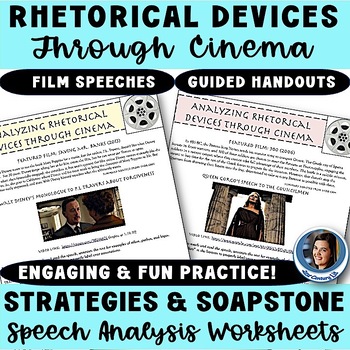
Analyzing Rhetorical Devices in Movie Speeches - Rhetoric Analysis Activities

Rhetoric in Movie Speeches Print & Digital Bundle - Rhetorical Devices & Appeals

Contemporary Speech - Rhetorical Devices

Rhetorical Analysis Unit Bundle - Appeals & Devices , High School Rhetoric Unit

Rhetorical Device Worksheet

Rhetorical Appeals & Devices Analysis Unit - Print & Digital Rhetoric Bundle

Rhetorical Devices Through Cinema Print & Digital Bundle - Analysis Activities

Speeches and Rhetoric Activity: Pixar Character Monologues

DIGITAL Great Debaters Rhetoric / Rhetorical Devices in Speech Analysis Review

Ethos, Logos, Pathos Task Cards for Stations or Gallery Walks
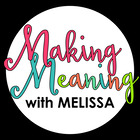
Rhetorical Analysis STARTER KIT - NOTES SLIDES, STUDENT HANDOUT, AND 10 EXAMPLES

ELA Grades 9-10 Quarter 3 Curriculum - 9 Weeks Rhetoric Unit, MLK, Argument Unit

Analyzing a Speech : The November 5th Speech in V for Vendetta

Rhetorical Analysis Writing Graphic Organizer for AP Lang

Rhetorical Analysis Graphic Organizer for Any Nonfiction Speech or Text

"Every Child Deserves a Champion," Engaging Rhetorical Analysis Practice

The Great Debaters - Final Debate Analysis Notes

Rhetorical Appeals and Devices Question Trail
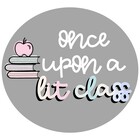
Persuasive Essay PPT

Declaration of Independence with Key

- We're hiring
- Help & FAQ
- Privacy policy
- Student privacy
- Terms of service
- Tell us what you think
The 30 Best Movie Inspirational Speeches
Cinema's most stirring oratories and spirit-raising team talks.
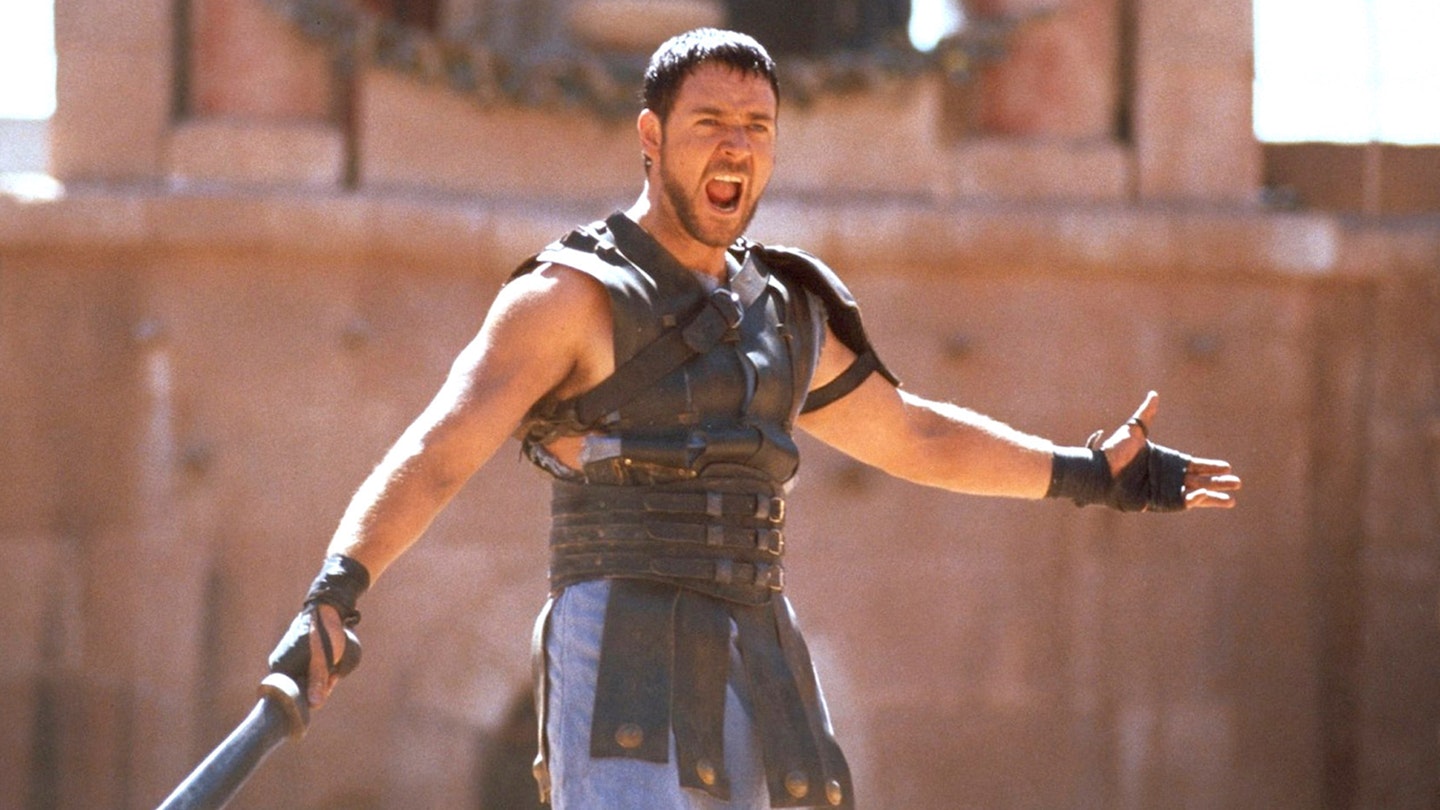
In times of trouble, you need a little help getting up and going, and film can often provide just that. Cinema has a long and storied history of providing great words of motivation and encouragement, sometimes for the characters' own benefit and occasionally to the audience. Here, we've chosen 30 of the best that should fit almost any occasion - but if you're really pressed for time, here are 40 condensed into a two-minute span { =nofollow}. If you have a little longer, read on!
Also: The 25 Best Movie Bollockings
The Great Dictator
Made at a time when the shadow of World War II was looming over Europe, Charlie Chaplin’s speech here – he’s playing a poor Jewish barber in disguise as a preening dictator and forced to address a Nuremberg-style rally – is a heartfelt plea for sanity and compassion in a time of madness. It’s the perfect antidote to extremism, and uses fiery rhetoric for good. If only we’d be able to pull this switcheroo in real life.
Buy The Great Dictator
Independence Day
Sure, there are cheesemongers with less cheese on offer than you see here and OK, the American jingoism doesn’t work at all for those of us not of a Yank disposition. But Bill Pullman’s slightly sheepish style blends here with steely determination, and he delivers the American St Crispin’s Day speech with conviction. Then, like any US President, he leaps into his fighter jet and flies off to battle aliens.
Buy Independence Day
For those who prefer a little humour in their motivational speeches, try the pitch-black streak in this opener, establishing Russell Crowe’s Maximus Decimus Meridius as a leader of men and a helluva guy. Galloping around the Legions in his cool armour and fur-lined cloak, you might question whether he really needs an entire army to back him up, but you’ll never doubt for a moment that they’d choose to follow him as he unleashes hell.
Buy Gladiator
Any Given Sunday
There’s a lot to be said for a little personal touch to leaven your high-flung rhetoric, and it’s a trick that Al Pacino uses well here, in the first of three American football speeches we’re going to include (hey, we can’t help it if the heavily-padded sport produces some great pep talks). Pacino’s troubled Tony D’Amato unveils his own problems with brutal honesty before using his own failures as a spur to rev on his team to greatness, speaking of team spirit and commitment as someone who has been known to suck at both.
Buy Any Given Sunday
Friday Night Lights
The film has been somewhat overshadowed nowadays by the equally good TV show that followed it, but watch Billy Bob Thornton here and be reminded that Kyle Chandler isn’t the only fundamentally decent man who can inspire a team of small-town boys to great efforts in pursuit of perfection. It’s also worth noting that he puts his emphasis here on excelling and not winning, making it clear that victory isn’t only measured by the scoreboard. Clear eyes, full hearts, can’t lose.
Buy Friday Night Lights
It is, and will probably always be, the greatest inspirational speech ever made. It’s endlessly flexible, and works even when not declaimed by the classically trained (see this Renaissance Man version for proof). And it’s by Shakespeare, still the best writer in Hollywood. We have, controversially perhaps, chosen Branagh’s version over Olivier’s because the latter sounds a little shrill to the modern ear, while Branagh convinces us that he could convince his men. This speech, given by the titular monarch to a vastly outnumbered force about to fight the French, obviously works especially well for English people, but by God, Harry and St George, it’s universal in its rousing effect.
Buy Henry V
This is a little-known film in the UK but it’s revered in certain communities in the US. Sean Astin’s Rudy has overcome dyslexia, poor grades and his relatively small stature to win a place on Notre Dame’s famous Fighting Irish American football team. Only problem is that he’s never been off the bench, and with his final game approaching he threatens to quit the team if he isn’t allowed to play – prompting this inspirational speech / telling off from a friend who points out that he’s being whiny and entitled and needs to grow a pair. Soon he’s back on the bench and given a starting position when his entire team threatens not to play unless he’s given a shot.
An honourable mention for Hector’s pep talk but Achilles wins the battle of the inspirational speeches just as he wins their duel (c’mon, that’s not a spoiler; it’s in the 2000 year-old Iliad). This is a short snippet, but then godlike Achilles, the man-killer, is a man of action rather than words. And what he does say – focusing on lions, glory and the manifold abilities of his small, hand-picked group of Myrmidons – would convince a rock to fight any Trojan who dared oppose it.
Animal House
Not every inspirational speech is about trying to inspire his cohorts to kill people or batter them up and down the length of a football field. Some aspire to a higher goal. Some aspire to debauchery, drinking and probably nudity. Some aspire to party like 1999 might have done had it tried harder. Some aspire to a particular kind of grubby, deranged greatness. One such is John Belushi’s Bluto, and this is the greatest night of his life.
Buy Animal House
The Goonies
Come the hour, cometh the man – and in this case the man is a small, asthmatic Sean Astin, inspiring his fellow Goonies to never say die and to keep going in their quest to find treasure and save their community. In his yellow rain slicker and with his voice on the edge of breaking he may not look like a modern Napoleon, but he has the same effect on his exhausted and discouraged troopers. He’s so good you’ll almost forget to laugh at his mentions of One-Eyed Willy. snigger
Buy The Goonies
The Lord Of The Rings: The Return Of The King
Death comes to us all, and Aragorn ain’t going to lie about it. But he still gees up his troops with the assurance that their civilisation will survive the onslaught of the forces of Mordor. Sure, they’re vastly outnumbered and sure, it seems likely that Frodo has failed in his quest to destroy the Ring in Mount Doom (especially if you’re watching the Extended Edition) but Viggo Mortensen’s Aragorn ensures that no one will be quitting any time soon. Not this day!
Buy The Lord Of The Rings: The Return Of The King
Bill Murray isn’t usually the guy you turn to for sincere, inspiring words of comfort. He’s more the type to puncture any attempt at same, and probably to fast-talk his opponents into giving up and going for a karaoke session while he’s about it. But after his heart grows two sizes during the course of Scrooged, he makes a plea for kindness and niceness from all mankind. He still does it in a recognisably Murray, manic and scattershot way, but that just makes him all the more compelling. Someone hire this man to play Santa Claus.
Buy Scrooged
Stirring sports speeches are limited to American Football. Miracle On Ice chronicles the based-on-truth tale of how the US Olympic hockey team triumphed over their Russian rivals. Kurt Russell's the speech-giver here, playing coach Herb Brooks. "Tonight, we are the greatest hockey team in the world," he tells them. You'll feel a swell of pride and inspiration too.
Rent Miracle
Deep Blue Sea
“You think water’s fast? You should see ice.” Samuel L. Jackson’s been around the block more than once, and he’s seen the worst of mankind. It’s with the weight of that history behind him that he takes charge and orders his fellow survivors of a marine disaster to start pulling together and quit arguing. His speech also has what is, unquestionably, the greatest punchline on this list. Still, it achieves the desired effect once everyone has quit screaming.
Buy Deep Blue Sea
If in doubt, steal from classical history, something that David Wenham’s Dilios demonstrates with aplomb here. In actual history, the one survivor of the 300 was so shamed by his survival that he executed a suicidal one-man attack on the Persians at this Battle of Plataea, but Wenham seems more in control and also like he has quite a bit of back-up. “The enemy outnumber us a paltry three-to-one,” notes Dilios triumphantly. Why, it was hardly worth the Persians turning up.
Good Will Hunting
Here’s an inspirational speech well-suited to highly-paid sports teams and the enormously talented. Ben Affleck’s argument is, basically, that if you’re lucky enough to get extraordinary chances in your life, it’s your duty to the rest of us schmoes to actually take those chances and run with them as far as you can. If you can get past the shellsuit and the hair, he’s basically Yoda-like in his wisdom.
Buy Good Will Hunting
Most people only remember the last word – “Freedom!” – but the rest of the speech is pretty killer too. Mel Gibson’s William Wallace starts off by puncturing his own legend, and acknowledges the urge to cut and run in the face of a far superior English force. But then he reminds his men what they’d be missing if they do, and soon they’re all back on side and facing down the hated English. By the end of this speech, you’ll all hate the English with them – even if you are one.
Buy Braveheart
Coach Carter
You’d expect the inspiration in this basketball film to come from the titular no-nonsense coach, played by a fiery Samuel L. Jackson. But in fact it’s one of his players who nabs the best lines, as he and the team sit studying to keep their grades as high as their scores. There is a little cheating here: Rick Gonzalez’ Timo actually steals his inspirational speech from Marianne Williamson (it’s sometimes wrongly attributed to Nelson Mandela) but he delivers it well so we’re going to allow it.
Buy Coach Carter
While it’s his skills in the ring that he is most lauded for, Rocky Balboa is something of a poet to boot. An incoherent one, certainly; a poet who says “I guess” a lot more often than Wordsworth might like, but a poet nevertheless. His moving words here, as he single-handedly ends the Cold War and ushers in a new era of East-West relations, are just one example. Another is…
Buy Rocky IV
Rocky Balboa
If his last speech was incoherent – in fairness, his rhythm may have been thrown off by the translator – this one verges on incomprehensible when he really gets going. Still, there’s real passion in Rocky’s plea for one last shot and an argument that’s applicable to all sorts of situations of institutional injustice or unfeeling bureaucracy.
Buy Rocky Balboa
Stand And Deliver
Those who've watched him on the modern Battlestar Galactica know that Edward James Olmos is a past master at giving speeches. This is him from a little earlier in his career, playing Jaime Escalante, a real-life teacher who inspired his students to stop dropping out and start taking calculus seriously. Here, he's handing out as pop quiz, so anyone having to home school their kids can take note.
Rent Stand And Deliver
Good Night, And Good Luck
This one is couched particularly at media moguls, but there’s a call for excellence and the highest moral standards here that we would all do well to live by. David Strathairn’s Edward R. Murrow, in a speech lifted directly from Murrow’s actual address to the Radio and Television News Directors Association in 1958, pleads for TV to inform as well as entertain. We feel that if more people saw this speech, Made In Chelsea would be cancelled immediately and reality TV would be banned, so spread the word!
Buy Good Night, And Good Luck
Anyone who has ever flirted with a romantic interest knows the risk of being knocked back, and Jon Favreau's Mike is experiencing a crisis of confidence. Luckily for him, he has Vince Vaughn's Trent to talk him back into the game, and Alex Désert's Charles to remind him that he's so money. He's a bear! And she's a bunny! Everything is going to be fine.
Buy Swingers
Charles Dutton’s second appearance on this list, after Rudy, sees him once again reminding lesser men (and women) to get with the programme, pull the finger out and generally stand up and be counted. But this time they’re facing unstoppable acid-blooded xenomorphs rather than American football players, so he has to be extra-emphatic.
Buy Alien 3
Pirates Of The Caribbean: At World’s End
Remarkably few women get to deliver inspirational speeches in movies – apparently they’re relegated to clapping admiringly from the sidelines. Thank goodness for Elizabeth Swan (Keira Knightley) who is elected King of the Pirates and rouses her troops into action for a last-ditch fight against the Lord Beckett’s overwhelming forces, led by the Flying Dutchman. She may not have quite the lungs of others on the list, but there’s no doubting her conviction as she calls for them to “Hoist the colours!” – the Jolly Roger – and sail out one last time.
Buy Pirates Of The Caribbean: At World’s End
The Replacements
One doesn’t expect lengthy speeches from Keanu “Woah” Reeves (although he’s done his share of Shakespeare actually) but he’s rarely more succinct and to the point than in this chat with his fellow Replacements. And in fact there are few speeches more likely to be effective in motivating an exhausted team for one last effort. “Chicks dig scars” could be used by virtually every example here to drive on the listeners.
Buy The Replacements
Bill Murray at it again, and once more an unconventional speech. This time out, he's John Winger, a loser who decides that he and best pal Russell Ziskey (Harold Ramis) will join the Army. Stuck with a group of oddballs, and, after a night of partying, decides to rally his fellow troops. It works... Sort of. But Murray's typically laconic style works well for the speech itself.
Rent or buy Stripes
The Lord Of The Rings: Return Of The King
All seems lost for Samwise Gamgee (Sean Astin again) and Frodo Baggins (Elijah Wood) as they lie, exhausted, on the slopes of Mount Doom. Frodo’s beyond endurance and raving as the influence of the Ring grows ever stronger on him, and his desperate straits drive Sam to one last push. It’s barely a speech, really – he uses his words better here – but there are few moments more inspirational.
Buy The Lord Of The Rings: Return of The King
The Shawshank Redemption
A quiet moment between Tim Robbins' Andy Dufresne and Morgan Freeman's Red became one of the more memorable moments in Shawshank , a movie with no shortage of them. And for those who are spending more time inside than perhaps they might be used to, Andy's musing on what he would do if he got out of prison are inspirational in themselves, even before he gets to that iconic line.
Rent The Shawshank Redemption
Avengers: Endgame
Steve Rogers, AKA Captain America, is not shy of breaking out speech mode when the moment calls for it. And inspiring the Avengers as they're about to embark on a trip through space and time to retrieve the Infinity Stones certainly seems like that moment. "Whatever it takes," indeed.
Rent Avengers: Endgame
- Newsletters
- Best Industries
- Business Plans
- Home-Based Business
- The UPS Store
- Customer Service
- Black in Business
- Your Next Move
- Female Founders
- Best Workplaces
- Company Culture
- Public Speaking
- HR/Benefits
- Productivity
- All the Hats
- Digital Transformation
- Artificial Intelligence
- Bringing Innovation to Market
- Cloud Computing
- Social Media
- Data Detectives
- Exit Interview
- Bootstrapping
- Crowdfunding
- Venture Capital
- Business Models
- Personal Finance
- Founder-Friendly Investors
- Upcoming Events
- Inc. 5000 Vision Conference
- Become a Sponsor
- Cox Business
- Verizon Business
- Branded Content
- Apply Inc. 5000 US
Inc. Premium

How Kamala Harris and Her Speechwriters Create Buzz-Worthy Messages
Kamala harris's acceptance speech relied heavily on rhetorical devices audiences like to hear..

The right words stir people to action. Political speechwriters are expert wordsmiths who work closely with candidates for elected office to give voice to their ideas.
This week, Vice President Kamala Harris and her speechwriters created some buzz-worthy moments during Thursday night's acceptance speech at the Democratic National Convention .
Harris's speech was reportedly co-written by Adam Frankel, who also worked on some of Barack Obama's major speeches early in his campaign and presidency. Frankel has also held positions as a speechwriter at major corporations, which should tell you that CEOs and senior executives are serious about the words they use when they shape and share their ideas.
Harris's collaboration with speechwriters such as Frankel resulted in several notable rhetorical devices throughout Thursday's speech. Here are a few:
Origin Stories Create Emotional Connections.
Origin stories don't always begin with the speaker's journey. A good writer often takes audiences back to the people or events that shaped the speaker's values.
For Harris, her origin story began with her parents.
"I'm no stranger to unlikely journeys," Harris said. "My mother was 19 when she crossed the world alone, traveling from India to California with an unshakable dream to be the scientist who would cure breast cancer."
Reflecting on her early memories as a child, Harris said that when she was playing in the park, her mother would say "Stay close." "But my father would say, 'run Kamala, run. Don't be afraid. Don't let anything stop you.' He taught me to be fearless."
When her parents divorced, Harris's mother raised her in a "beautiful working-class neighborhood of firefighters, nurses, and construction workers.... Mrs. Shelton ran the day care below us and became like a second mother. Uncle Sherman, Aunt Mary, Uncle Freddie, Auntie Chris, none of them family by blood and all of them family by love."
Harris credited her mother for her enduring values:
My mother taught us values: community, faith, and treating others the way you would want to be treated, with kindness, respect, and compassion. She was tough, courageous, a trailblazer in the fight for women's health, and she taught us to never complain about injustice but to do something about it. Do something about it.
Origin stories should have just enough detail to paint a vivid picture of a person's past, while revealing the values that molded the speaker into the person she is today.
Rhythm and Rhyme.
Harris uses alliteration and other linguistic devices to make phrases sound pleasant to the ear. These are often the quotes that catch a lot of buzz on social media.
For example, Harris used alliteration (the same letter or sound at the beginning of successive words) when she said that she's "a leader who leads and listens... and always fights for the American people. From the courthouse to the White House, that has been my life's work."
Harris is also fond of using a powerful rhetorical technique called anaphora, repeating the same words or phrases at the beginning of successive sentences. For example, Harris said,
As a young courtroom prosecutor... I stood up for women and children against predators who abused them. As attorney general of California, I stood up against the big banks. I stood up for veterans and students being scammed for not-for-profit colleges.
Harris also uses parallelism, the repetition of a similar grammatical style in the same sentence. For example, Harris said, "I fought against the cartels who traffic in drugs, and guns, and human beings."
Grammatically, Harris could have simply said "drugs, guns, and human beings." But adding "in" and "and" creates a parallel structure that enhances the power of the sentence.
Harris went on to say that the cartels she fought against "threaten the security of our borders and the safety of our communities." Once again, she's delivering a sentence that has two parallel parts of five words: the security of our borders/the safety of our communities.
When Harris wrapped up sections of her speech that employed anaphora and parallelism, the audience rose to their feet in applause. But the biggest cheers and chants occurred when Harris painted a contrast with Donald Trump.
We are not going back to when Donald Trump tried to cut Social Security and Medicare. We are not going back to when he tried to get rid of the Affordable Care Act.... We are not going to let him eliminate the Department of Education that funds our public schools. We are not going to let him end programs like Head Start that provide pre-school and child care. America, we are not going back .
The audience picked up on Harris's rhythm and began chanting "Not going back! Not going back!"
Harris also uses the rhetorical device called antithesis, the contrasting of ideas in the same sentence. For example, Harris received an enthusiastic response when she said, "None of us has to fail for all of us to succeed."
People like to hear messages wrapped in poetic features like rhythm and rhyme. It gets them on their feet.
In her speech, Harris sought to portray herself as a confident commander-in-chief and took several shots against her opponent. We'll know soon enough if Harris's speech resonates with voters, but the acceptance speech gives us a glimpse of the rhetorical style she'll use to express her ideas.
A refreshed look at leadership from the desk of CEO and chief content officer Stephanie Mehta
Privacy Policy
Advertisement
Where Kamala Harris Stands on the Issues: Abortion, Immigration and More
She wants to protect the right to abortion nationally. Here’s what else to know about her positions.
- Share full article

By Maggie Astor
- Published July 21, 2024 Updated Aug. 24, 2024
With Vice President Kamala Harris having replaced President Biden on the Democratic ticket, her stances on key issues will be scrutinized by both parties and the nation’s voters.
She has a long record in politics: as district attorney of San Francisco, as attorney general of California, as a senator, as a presidential candidate and as vice president.
Here is an overview of where she stands.
Ms. Harris supports legislation that would protect the right to abortion nationally, as Roe v. Wade did before it was overturned in 2022, in Dobbs v. Jackson Women’s Health Organization.
After the Dobbs ruling, she became central to the Biden campaign’s efforts to keep the spotlight on abortion, given that Mr. Biden — with his personal discomfort with abortion and his support for restrictions earlier in his career — was a flawed messenger. In March, she made what was believed to be the first official visit to an abortion clinic by a president or vice president.
She consistently supported abortion rights during her time in the Senate, including cosponsoring legislation that would have banned common state-level restrictions, like requiring doctors to perform specific tests or have hospital admitting privileges in order to provide abortions.
As a presidential candidate in 2019, she argued that states with a history of restricting abortion rights in violation of Roe should be subject to what is known as pre-clearance for new abortion laws — those laws would have to be federally approved before they could take effect. That proposal is not viable now that the Supreme Court has overturned Roe.
We are having trouble retrieving the article content.
Please enable JavaScript in your browser settings.
Thank you for your patience while we verify access. If you are in Reader mode please exit and log into your Times account, or subscribe for all of The Times.
Thank you for your patience while we verify access.
Already a subscriber? Log in .
Want all of The Times? Subscribe .
|
COMMENTS
Rhetorical analysis is a skill that needs practice and reinforcement all year long. Using various moments from movies and film offer a great chance to examine both the rhetorical situation and the arguments themselves. Check out these eleven movie suggestions to teach rhetorical analysis including various Disney movies, The Notebook, and We Are ...
Click on the graphic below for my Movie Speech Rhetorical Analysis Resource. Coach Brooks Addresses the US Hockey Team "Miracle" 2004. Powerful sports speeches are always a great asset to rhetoric units. Heavy with pathos, this speech uses repetition and anastrophe to grab the attention of the players before they begin an Olympic championship.
Speech Bank: Top 100 Speeches: Great New Speeches: Obama Speeches: GWB Speeches: Movie Speeches: Rhetorical Figures: Christian Rhetoric: 9/11 Speeches: News and Research: For Scholars: Rhetoric Defined: Corax v. Tisias: Plato on Rhetoric: Aristotle on Rhetoric: Comm Journals: Comm Associations: Cool Exercises: Rodman & de Ref: Speech Quiz #1 ...
Rhetorical Analysis of Film - Elements of Film. Rhetorical choices in film are made on the narrative level (of story/plot), the visual level, and the audio level. Camera range, camera angles, point of view, lighting, editing, sound--these are rhetorical devices (aka elements of film) that directors use to signify meaning, tone, and emotions.
American Rhetoric: Movie Speech "To Kill A Mockingbird" (1962) Atticus Finch delivers his Closing Argument at the Trial of Tom Robinson
Movie speeches have a way of seeping into our collective consciousness as a society, and people often quote recognizable snippets from cinema in conversation in order to sum up their feelings or provide relatable wisdom in a variety of contexts. ... 17 rhetorical devices that will make you sound like Steve Jobs.
Speech Bank: Top 100 Speeches: Great New Speeches: Obama Speeches: GWB Speeches: Movie Speeches: Rhetorical Figures: Christian Rhetoric: 9/11 Speeches: News and Research: For Scholars: Rhetoric Defined: Corax v. Tisias: Plato on Rhetoric: Aristotle on Rhetoric: Comm Journals: Comm Associations: Cool Exercises: Rodman & de Ref: Speech Quiz #1 ...
Try beginning your rhetorical analysis lessons by focusing on the rhetorical situation before heading into deeper analysis. When you're ready, dig in using SPACE CAT and a great song from a musical that has a premise and an argument to examine. ... You might have a speech, a commercial, another song, or another type of fictional scenario, and ...
Rhetorical device no. 1: Anaphora (means carrying up or back) The repetition of a word or phrase at the beginning of every clause. " As you know, we've got the iPod, best music player in the world. We've got the iPod Nano's, brand new models, colors are back. We've got the amazing new iPod Shuffle .".
Leaving out conjunction words (as or and) from a sentence. "…and that government of the people, by the people, for the people shall not perish from the earth.". - Abraham Lincoln. 10. Assonance: Repeating a vowel sound in a sentence. "I feel the need, the need for speed". - Tom Cruise (from the movie Top Gun) 11.
Teaching rhetorical analysis is one of my absolute favorite units to complete with my students. I love teaching my students about rhetorical strategies and devices, analyzing what makes an effective and persuasive argument, and reading critical speeches with my students. Here is a quick list of some of my favorite speeches for rhetorical analysis.
An example of this device would be "The movie is a soulless, ... Examples of Rhetorical Devices in Speeches and Events. Rhetorical devices are essential tools for speakers to effectively communicate their message and engage their audience. By employing various linguistic techniques, speakers can elevate their speech, making it more impactful ...
America Ferrera in 'Barbie' (2023) This is the battle cry with the answer Barbie's been searching for: stop worrying if other people like you because you cannot live up to other people's expectations. You must accept your true self, flaws and all, despite all the twisted messages society sends you. This is easier said than done of course ...
Martin Luther King Jr.'s famous "I Have a Dream" speech is a powerful example of anaphora. The repetition of the said "I have a dream" emphasizes his vision for a more equal and just society. Example 3: Metaphor. "Our life is like a journey on a train, with its stations, with changes of routes, and with accidents!".
This fun rhetoric bundle includes fun and engaging rhetorical analysis practice worksheets (rhetorical devices and appeals) for 13 different cinematic movie speeches. Most of the time, a rhetoric unit can become boring and irrelevant for advanced middle or high school students, who beg to have real-. 2. Products. $7.50 $9.98 Save $2.48.
F or each rhetorical device, definitions and examples (text, audio, video) are provided. Audio and video examples are taken from public speeches and sermons, movies, songs, lectures, oral interpretations of literature, and other media events. S ome artifacts have been edited further to make the devices easier to detect.
An expression of real or pretended doubt or uncertainty especially for rhetorical effect. to be, or not to be: that is the question. cacophony | see definition ». Harshness in the sound of words or phrases. chiasmus | see definition ». An inverted relationship between the syntactic elements of parallel phrases.
Rhetorical Devices, Ethos, Logos, and Pathos, are the bones of any persuasive argument. These task cards, which are perfect for stations or gallery walks, will help your students identify and analyze Ethos, Pathos, and Logos in context.This resource provides 39 cards, 13 of each Ethos, Logos, and Pathos, as well as a printable chart for ...
Animal House. Not every inspirational speech is about trying to inspire his cohorts to kill people or batter them up and down the length of a football field. Some aspire to a higher goal. Some ...
Will: Of course that's your contention.You're a first year grad student. You just got finished readin' some Marxian historian -- Pete Garrison probably. You're gonna be convinced of that 'til next month when you get to James Lemon, and then you're gonna be talkin' about how the economies of Virginia and Pennsylvania were entrepreneurial and capitalist way back in 1740.
Literary devices and figures of speech are both techniques used in writing and speaking; however, they serve different purposes and are used in different ways.. Literary devices are techniques or tools that a writer uses to create a specific effect or convey a certain meaning. These devices include elements of language, structure, style, and narrative technique.
Kamala Harris's acceptance speech relied heavily on rhetorical devices audiences like to hear. Shape Expert Opinion By Carmine Gallo , Harvard instructor, keynote speaker, author, 'The Bezos ...
President Thomas J. Whitmore Addresses to the U.S. Fighter Pilots. Audio mp3 delivered by Bill Pullman. The President: Good morning. In less than an hour, aircraft from here will join others from around the world. And you will be launching the largest aerial battle in this history of mankind. Mankind -- that word should have new meaning for all ...
In a speech in 2022 marking the anniversary of the Jan. 6, 2021, attack on the Capitol, she said that day had showed "what our nation would look like if the forces who seek to dismantle our ...
Speech Bank: Top 100 Speeches: Great New Speeches: Obama Speeches: GWB Speeches: Movie Speeches: Rhetorical Figures: Christian Rhetoric: 9/11 Speeches: News and Research: For Scholars: Rhetoric Defined: Corax v. Tisias: Plato on Rhetoric: Aristotle on Rhetoric: Comm Journals: Comm Associations: Cool Exercises: Rodman & de Ref: Speech Quiz #1 ...
Speech Bank: Top 100 Speeches: Great New Speeches: Obama Speeches: GWB Speeches: Movie Speeches: Rhetorical Figures: Christian Rhetoric: 9/11 Speeches: News and Research: For Scholars: Rhetoric Defined: Corax v. Tisias: Plato on Rhetoric: Aristotle on Rhetoric: Comm Journals: Comm Associations: Cool Exercises: Rodman & de Ref: Speech Quiz #1 ...